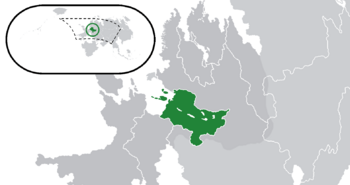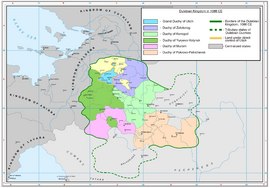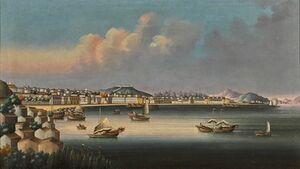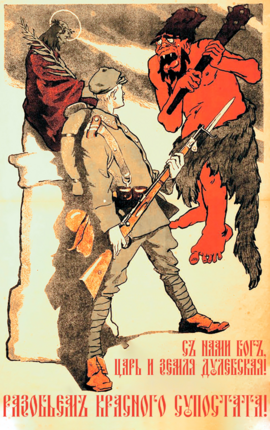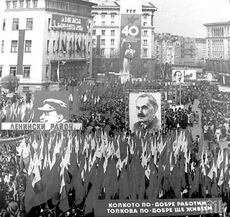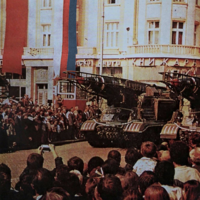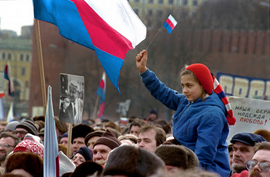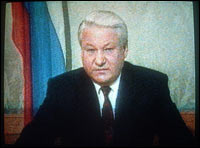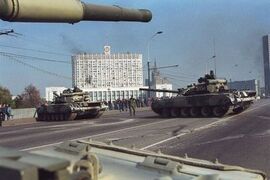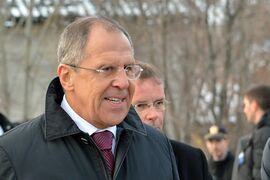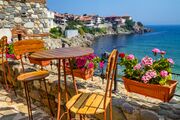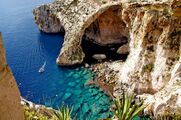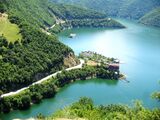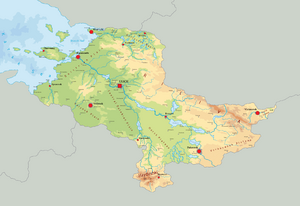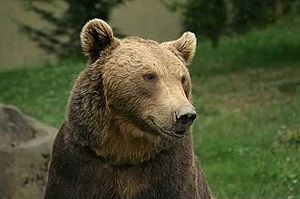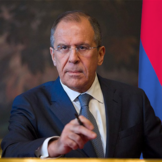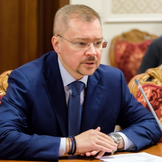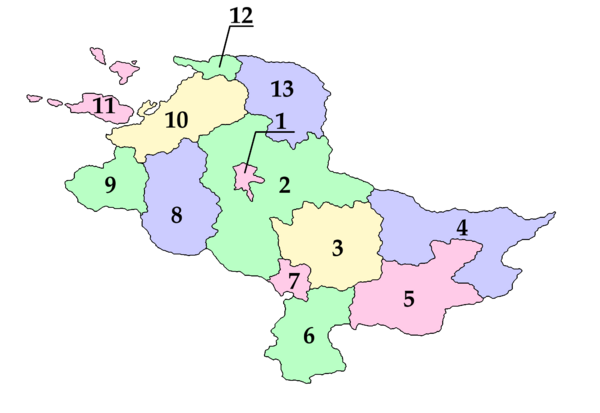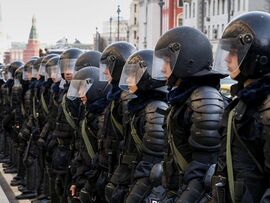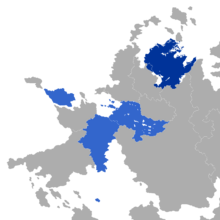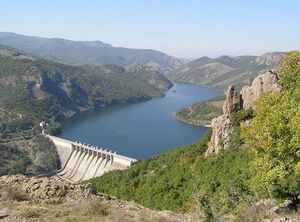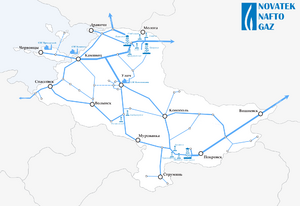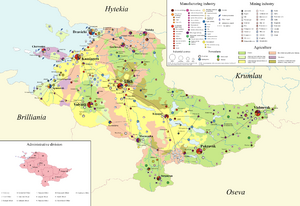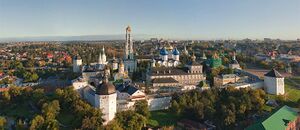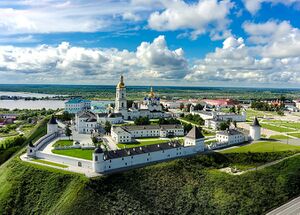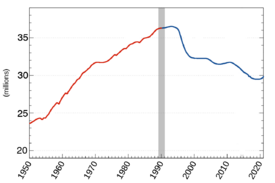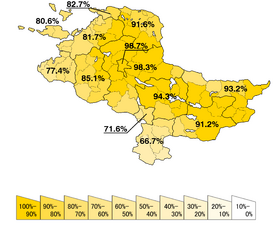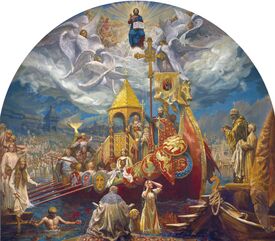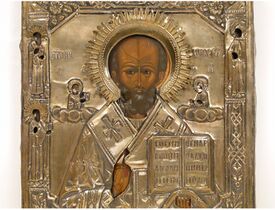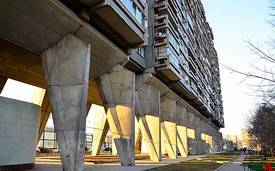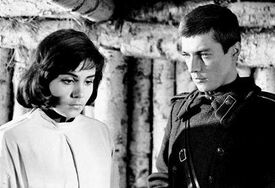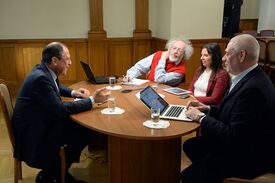Dulebia
Republic of Dulebia Респýблика Дулéбия (Dulebian) (Respúblika Dulébiya) | |
|---|---|
| Motto: Вeра и слава (Dulebian) Faith and glory | |
| Anthem: Ода Свободе
(Oda svobode) Ode to freedom | |
Location of Dulebia (green) in Berea (dark grey) | |
| Capital and largest city | Ulich |
| Official languages | Dulebian |
| Recognised national languages | See National languages in Dulebia |
| Ethnic groups (2018) | 73% Dulebian 12.3% Balkarians 7% Lavarian 3.8% Telmerian 2.7% Murian 1.2% other |
| Religion | TBD |
| Demonym(s) | Dulebian |
| Government | Presidential republic |
• President | Alexey Volodin |
• Prime Minister | Vladimir Klishes |
• Chairman of the Veche | Antoaneta Petrovna |
| Legislature | Dulebian Veche |
| Formation | |
| 861 CE | |
| 1218 CE | |
| 1721 CE | |
| 17th of September, 1916 | |
| 12th of March, 1920 | |
• Current Constitution | 31st of January, 2001 |
| Area | |
• Total | 323,246 km2 (124,806 sq mi) |
• Water (%) | 7.1 |
| Population | |
• September 2016 estimate | 29,911,651 (9) |
• February 2017 census | 29,894,117 |
| GDP (PPP) | 2019 estimate |
• Total | $733.3 billion |
• Per capita | $24.529.91 |
| GDP (nominal) | 2019 estimate |
• Total | $534.5 billion |
• Per capita | $17,879.8 |
| Gini (2016) | 36.9 medium |
| HDI (2014) | 0.837 very high |
| Currency | Chervonets (Ћ) |
| Time zone | TBA |
| Date format | dd-mm-yyyy |
| Driving side | right |
| Calling code | +223 |
| ISO 3166 code | MB |
| Internet TLD | .db |
Dulebia (Dulebian: Дулебия, tr. Dulebiya), officially the Republic of Dulebia (Dulebian: Республика Дулебия, tr. Respublika Dulebiya), is a country in Berea, to the south of the Telmerian peninsula. At 312,968 square kilometres (120,837.62 sq mi), Dulebia is the 4th largest country in the world by area, and the 5th most populous, with about 29 million people as of 2017. Dulebia's capital and largest city, Ulich, is the largest metropolitan area in the country and one of the largest cities in Berea; other major cities include Kamianets, Pokrovsk, Volynsk and Vishnevsk. Dulebia spans one time zone and incorporates a wide range of environments and landforms. Dulebia shares a land border with Lavaria to the west, Krovech to the south and Rovina to the northeast, and borders the Karsk Sea to the northwest, where it shares a maritime border with Falland and Sarrac.
The oldest known tribes to inhabit the current territory of Dulebia were of Telmeric origin and settled in the area approximately 900 years BCE. Most of present-day Dulebia came under the control of the Cambran empire in 116-120 CE during the conquests of emperor Arcadius. The river of Dnistr became the frontier of Cambran expansion to the north. Following the deterioration of the empire in the early 4th century, the Cambran possessions became part of the Cambran Triumvirate. The empire experienced an invason of northern Telmeric tribes in 340-360 CE, and the Dulebian possessions were first sacked from Alarich, king of the Welbarians, and then by the Aldens in 372 CE. Following the fall of Cambra, the area was under the control of Telmeric kingdoms for five centuries. In the 9th century various Pomoric tribes invaded the Mursk plateau and the Dulebian plain and established their first organised states in the area. Under the influence of their Telmeric and Lavarian neighbours, the Pomorian states desintegrated into a number of duchies, the small Duchy of Ulich established itself as the most influential and prosperous in the area.
The unification of the duchies started in the 10th century and was completed in the early 11th century, when Dulebia emerged victorious from the Trouble times, a brief period of political crisis and Aldenian intervention in the country. The kingdom became expanding to the south and subjugated several nomadic tribes, most notably the Alans. Dulebia lost most of its territories to the south of the Haydushki mountains in the late 14th century to the advanse of the Gurkhanate, however, the Gurkhans failed to invade the inner possessions of the kingdom: Dulebia remained mostly untouched by the Gurkhan invasion, which gave it the possibility to prosper in contrast to its western allies. The Dulebian Kingdom experienced its period of Renaissance in the 15th century, mostly under the rule of Tsar Mikhail III, the Kingdom was reformed under the influence of the growing Lavarian Kingdom to the west and the Kingdoms of Cuthland and Waldrich to the north.
Dulebia experienced a second wave of reforms targeted at its westernization in the early 18th century under Tsar, and later Emperor Peter II: the Kingdom was reformed to an empire, and the former type of ruling, de-facto a constitutional monarchy, was disbanded in favour of an absolute monarchy. Dulebia took part in the War for Haltboruh succession, and annexed the Kingdom of Aldena and the Duchy of Spira in 1745-1747, gaining access to the Karsk sea. As a winner in the War for Haltboruh succession, Dulebia was granted some of the former colonies of the Cuthish empire, most notably in Pamira and Melasia, starting the Dulebian colonial empire. During the Karsk sea war, Dulebia gained territory on the TBA peninsula, and in the late 19th century it caused severe defeats to the Aleinish and Lavarian fleets, effectively taking full control over the Karsk sea and using it as its base of operation across Aurorum. Dulebia entered the Great Berean Imperialist War as member of the Central Pact and an ally of Cuthland. Its defeat was followed by the Dulebian revolution and a civil war, and a communist regime was established in the country.
The communist regime in Dulebia lasted from the end of the Dulebian civil war in 1919 until 1990. The country engaged actively on the foreign arena, funding communist movements in numerous post-colonial countries. Dulebia was rapidly industrialized in the 1920s-1930s, and supported Cuthland during the Melasian crisis. The Dulebian economy became stagnating in the late 1960s, following a worsening in the relations with Cuthland. Following a severe financial crisis in 1985-1987, and a series of liberal reforms, the People's Republic of Dulebia was dissolved in 1990. In the following three years, the country went through a number of economic reforms and a shock therapy, which escalated into a coup d'etat, staged by members of the former Communist party of Dulebia. In 1993, following a number of events now known as the 9-day war, the president of Dulebia, Oleg Beglov, and his cabinet lost all power to the former communist party members, who rule the country since then.
Dulebia's economy ranks as the 9th largest by nominal GDP and 8th largest by purchasing power parity in 2018. Dulebia is a major importer of copper, iron and aluminium,as well as food products, most notably meat, while focusing on fossil fuel, electricity and arms exports. Dulebia is a major exporter of natural gas, the biggest in Berea, and is also a major exporter of lignite, anthracite, and refined oil and oil subproducts. The country is one of the recognized nuclear power users and possesses 8 nuclear powerplants. Dulebia has one of the highest percentages of renewable energy in the total energy production, mostly benefiting from its several major rivers. The country is highly industrialized and has one of the highest levels of urbanisation and education among developing countries, however, it is crippled by corruption, placing itself last in the Corruption Perceptions Index in Berea and 11th in the Democracy index of Aurorum.
Etymology
The name Dulebia originates from the name of the Pomorian tribes that invaded the Mursk Plateau and later the Central Dulebian Plain between the 8th century CE and the 9th century CE. The name of the tribes themselves has three possible etymologies, all of which are currently recognised by the Dulebian scientific society:
- The Telmeric word deud(a)-laibaz, translating as national heritage (dul. Национальное наследие). This etymology is often critisized, as Telmerian experts point out that this word would be pronounced as tjudlebi (dul. Чулебы) in Dulebian.
- Another possibility is the Telmeric word dudl-eiba, meaning dawdle, delay (dul. Волынить). This etymology has the most supporters, as records say that a Dulebian fortress was documented by Aldenians as Dudl-eiba as early as in the 9th century CE, a fortress that is currently known as the city of Volynsk (dul. Волынск)
- The third possibility is the Telmeric daud-laiba, meaning heritage of the dead. It was offered by Professor Simeon Korneyev, Soviet historian and linguist, in 1961, and was the official etymology until the dissolution of the People's Republic in 1990.
History
Part of a series on the |
||||||||||||||||||||||
|---|---|---|---|---|---|---|---|---|---|---|---|---|---|---|---|---|---|---|---|---|---|---|
| History of Dulebia | ||||||||||||||||||||||
|
||||||||||||||||||||||
| Timeline | ||||||||||||||||||||||
Prehistory and Antiquity
The oldest human settlements in Dulebia date from 48,000 years BC. During research, specialists have found several neanderthal villages, a stone temple, fireplaces, and instruments, as well as mammoth bone dwellings on the coasts of the Karsk sea as well as along the Dnistr river. The oldest civilization confirmed by archeologists to have existed on the current territory of the country is the Agretta culture of the Karsk sea coast around Dravichi. The northern territory is considered part of the birthplace of the Foranic culture. Foranic tribes inhabited the majority of the territory of the country from 700 BCE. The Foranic tribes remained largely decentralized throughout their existence. In 200-150 BCE there is evidence of Welbarian and Aldenic tribes invading into Northern Dulebia. During this period, most of the Foranic tribes in the region were either destroyed, or absorbed into the Telmeric Welbarian tribes.
The Cambran Empire invaded the region in 120 CE under the rule of Emperor Arcadius. Most of the Foranic tribes to the south of the Dnistr were subjugated by the Cambrans and taken as foederati into the Cambran army. Numerous attempts of Cambran emperors to cross the Dnistr and invade the land to its north ended up as failures: the thick forests and vast marshes of Northern Dulebia proved unpassable for the Cambran legions. Under the Cambran empire, Dulebia was split into several regions and provinces. The Karsk sea coast received the name Carra Minor, while the Central Dulebian plain was named Velbaria Minor; the territory to the north of the Dnistr was named Velbaria Magna. The region prospered under the Cambran rule: several big cities were established, most notably the fort of Ulbia, which would later become Ulich, and the coastal port of Histria, future Kamianets. Benefiting from its geographical location, the Cambran region became centre of trade and manufacture, and was one of the richest regions in the northern part of the Empire. Following the Partition of Cambra, Velbaria Minor and Carra Minor found themselves within the Northern Triumvirate of the empire. With the deterioration of the Cambran state in the 2-4 centuries, the border regions began distancing themselves from the central Cambran authority: a process that was often ecouraged by the imperial centre itself, as the region suffered greatly from attacks on the frontier of the Camnran empire. The high concentration of foederati and the constant attacks from Welbarian tribes from across the Dnistr forced the Cambran emperors to give local rulers more and more authority, to a point when in the early 4th century they were allowed to construct their own castles to protect the frontiers of the empire.
Late Antiquity and Dark Ages
The early 4th century saw a period of climatic anomally, known as the Little Ice Age. Numerous Telmeric tribes from the territories of modern-day Mascylla and Cuthland conducted a great migration southward, towards the warmer and more fertile land of the Central Dulebian Plain, pushing already existing Welbarian tribes across the Dnistr into the weakened and decentrlized Cambran empire. Initial attempts to integrate the Welbarians into the Cambran society failed, and the Welbarians rebelled in 310 CE, scorching several cities in the province of Velbaria Minor and leading a campaign against the Cambran heartlands in the next decades. Simultaniously, a Telmeric tribe known as the Aldiens crossed the Dnistr in 320 CE and settled in modern-day Dulebia, forming one of the oldest Barbarian kingdoms, the Kingdom of Aldiens, in 332 CE. Between 385 and 390, the Kingdom fought a long and unsuccessful war with King Alarich of the Welbarians, the result of which was the absorption of the Aldiens into the Welbarian Kingdom, the successor of the Cambran empire in Central Berea. Aldiens remained within the kingdom up until its dterioration.
The 6th-7th centuries saw a period of formation of feudalism within the previously homogenous Barbarian kingdoms. This process was also present in the Welbarian Kingdom. The lands of modern-day Dulebia slowly disintegrated into numerous small duchies and principalities, and started functioning automously from the royal centre in Cambra as the Welbarian kingdom grew weaker. In 610-615, the region suffered from a civil war caused by a severe famine and religious unrest As a result, the Kingdom of Aldena managed to claim independence from the Welbarians, with Liutprand being crowned as the first King of the newly formed Kingdom of Aldena in 619 CE. The kingdom sustained a policy of militarist expansion throughout the next century, managing to capture most of modern-day Dulebia and advance into Lavaria. The Aldenic Kingdom became the most influential state of the region in the 8th century. Aldena was the centre of Medieval culture: numerous monasteries and schools were opened under King Theodorich between 710 and 740, and the first chronicles and examples of medieval literature in Berea date from the rule of Childeric the Bald in 750-780. However, as the process of decentralization and feudalism progressed, the kingdom quickly found itself in a state of internal struggle for power, and by the early 9th century it collapsed into a period of civil wars.
Invasion of Dulebian tribes and Grand Duchy of Ulich
During the late 8th century, the Carpa and Tayar plains, inhabited by numerous Pomorian tribes since the fall of the Cambran empire in the 4th century, experienced an invasion of Nomadic tribes from the east, most notably Alans, as well as the Sfaridic Caliphate under Mehmet I from the south. Pomorian villages and towns were continuously sacked and destroyed by the invaders, forcing the Pomorian tribes to migrate and seek a safer place to settle. Several tribal groups, most notably the Dulebi, Balkari and Muri, attempted to cross the Verkhoyansk mountains to the north, and invaded the Mursk plateau as well as the Dulebian plain in the early 8th century. The tribes settled around the rivers Mura and Dnistr, forming the earliest known tribal confederations of Pomorians in the area. Several important cities were established, including the city of Pokrovsk. The difficult, swampy terrain soon forced some of the tribes to continue to the north, where they came in contact with the Kingdom of Aldena. Aldena itself experienced a period of civil war that started in 746, and was unable to repel the Pomorian tribes on its southern frontiers. The Pomorians sacked several cities in 750-780, but were unable to launch a full-scale invasion into the kingdom due to their lack of organisation and proper leadership. This would change in 798, when they destroyed the main army of the Aldenians led by King Telorian, in the Battle of Karlovo Marshes. Unified by commander of Aldenian origin, whose name remains uncertain for modern historians, the Pomorian tribes led an organised invasion into the Aldenian kingdom in 803-816, and managed to take several major cities. The Pomorian tribes continued their expansion into Aldena, and in 846 they managed to besiege and capture the Aldenian capital, the city of Ulbia, and sacked it. Ulbia, which was constructed by the Cambrans in the second century, was one of the richest cities of the Early Middle Ages, and quickly became the most important city of the newly-formed Pomorian state itself.
Under the influence of the neighbouring kingdoms, the Pomorian state pretty quickly experienced a process of decentralization typical for the feudal era. Ulbia preserved its dominance as the centre of the Pomorian culture, however, several other duchies, most notably Yuryevo-Volynsk, Pokrovo-Petrichevsk, Konopol, often had bigger military power and were more prosperous than Ulbia. The status of Ulbia as the political centre of the Pomorian kingdom caused numerous conflicts among Pomorian dukes for the nominal title of King of Pomorians in the following several centuries. The state was forcefully baptised in the 10th century, with the process starting with the Great Baptism of Ulich in 934, conducted by Duke Mikhail I the Baptist. In the late 10th century, the crisis of power and the internal instability in the kingdom was used by Aldena: Ulbia, now renamed to Ulich, was conquered and a king of Albian origin was throned as King of Pomorians. This brief period remains in the Dulebian history as the Trouble times of 982-1004. Following a civil revolt, the Albenians were driven away from Dulebia, and the Kingdom of Dulebia emerged. The new kingdom became more centralized and focused around the Grand Duchy of Ulich. Until the end of the century, the kingdom began rapidly expanding, subjugating the Dobrinichi and Kulibi tribes on the eastern and southern frontiers of the country.
Dulebian Kingdom
During the 12th century, the Dulebian Kingdom followed the general trend of Berean states during the High Middle Ages: it began slowly centralizing its power, and the Grand Duchy of Ulich slowly grew in power and prosperity. However, this process was a lot slower than the similar processes that neighbouring Aldena and Lavaria. As a result, the kingdom was thorn by constant in-fighting among noble houses and dukes for the throne of Ulich. In 1221, the throne of Ulich was taken by Vasily I Dolgoruky. The new Grand Duke attempted the first radical reforms of the state influenced by the northern Kingdom of Aldena. Vasily tried to get rid of the noble families and dukes of the various duchies within the kingdom that previously heavily influenced the policy of Ulich. His attempts, which involved armed conflicts with some duchies, proved to be mostly successful, but resulted in general distrust among Dulebian nobles towards Vasily himself.
In 1235, Khan Zengui of the Chaghanid Empire invaded Berea through the Verkhoyansk Plateau, threatening the Kingdom of Dulebia itself. The neighbouring Cuman and Pecheneg tribes fell to the Chaganid advance, and many of them crossed the Verkhoyansk plateau seeking refuge in the Dulebian kingdom. They were allowed to settle in the country in exchange of embrasing semitarism annd joining the Dulebian king against the Chaganids, which they accepted. In 1239, Zengui declared war on the Dulebian Kingdom and moved north, crossing the Verkhoyansk plateau. Due to the internal instability of the Dulebian state, and the distrust of the nobles towards the Dulebian king, many refused to aid him against the advancing hordes, and some even supported Zengui in his conquest, hoping to gain power in case of victory. Vasily managed to gain support only from the duchies of Murom and Pokrovo-Petrichevsk. His army met the Chaganids in the Battle of the Vacha Pass, where he was betrayed by his nomadic allies, encircled, and lost almost all of his men. Zengui allowed Vasily and some of his men to escape the encirclement, who fled back to Ulich, leaving the Dulebian lands to the mercy of the Gurkhan. Several big cities were purged and entirely razed between 1240 and 1242, with Zengui reaching Ulich by March 1242, forcing Vasily to leave to Aldena. With the support of the Aldenic king Alarich XVI the Bald, the Dulebians laid down the siege of Ulich, forcing Zengui to flee to the west, where he sacked the city of Volynsk in Dulebia and Gabes in Aldena, later invading the neighbouring Lavarian Kingdom. Alarich XVI used the opportunity to overthrow and assassinate Vasily I in 1245, taking over Ulich and declaring himself King of Aldenics and Dulebians, a period that lasted a decade until the death of the Aldenic king in 1251. Alarich managed to subjugate only a small portion of the Dulebian lands under his crown, while to the south the Dulebians united and assembled an army under Boris Vasylevich, son of Vasily, which marched to Ulich in 1252, and took it with the help of a peasant revolt happening within the city itself.
Boris was crowned King of Dulebia, and unlike his father, he managed to consolidate all of the power in the state in his hands while also winning the support of the Dulebian nobles. While Boris supported and continued a lot of the reforms of his father, he started relying more on the nobles while also focusing his attention on the costruction of fortresses and castles and stone walls to protect the major cities of the kingdom. Boris paid significant attention to the cities of the kingdom, making them more influential and protected, learning the lessons of the Chaganid invasion of 1240. This proved successful, as Boris managed to repel the invasion of Zengui in 1260, the latter failing to capture Konopol, suffering a strategic defeat in the Battle of the River Dnistr, and fleeing to Rovina. The Chaganid invasion of 1260 brought the Black Plague, which struck the country and killed almost one-fourth of the Dulebian population, rapidly spreading throughout Berea. The Dulebian Kingdom saw its Golden Age during the rule of Mikhail III, grandson of Boris. Mikhail III initiated a series of reforms that copied the reforms held earlier in neighbouring Lavarian and Aldenic kingdoms. Dulebia received its first Codex of Laws, slowly transitioned to the neo-Cambran law used in Aldena, received its first state flag. Mikhail initiated the construction of several monumental semitarist temples, and crowned himself as the first Caesar (Tsar) of Dulebia. Under his rule numerous seminaries and schools were opened, and the first national archive in Dulebia was established. The period saw the development of the Dulebian religious icon and mosaic art, and the first chronicle of the state was written by Metodius of Murom. Benefiting from its strategic location on the junction between Telmeria, Siamia and the rich Pamiran trade routes, Dulebia quickly enriched itself, becoming one of the most prosperous states of the High Middle Ages and surviving the Black Plague with relatively limited effect on its economic growth, at least compared to its neighbours.
During the Late Middle Ages, Dulebia became heavily influenced by the Aldeno-Erjarvian Commonwealth, a powerful state that established itself on the Karsk sea and absorbed both the previous Kingdom of Aldena and the Duchy of Erjarvia, as well as numerous smaller principalities. Under Tsar Yury the Reformator, an early form of parliament, the Zemsky Sobor, later renamed to Veche, was formed. Consisting of noble representatives of the Dulebian duchies, the Veche was tasked with the governance of the country and the election of the Tsar for life: Dulebia was reformed into one of the oldest elective monarchies. The land reform of Yury untied the peasants from the land of their lords and granted them the freedom of movement, the taxation reform lowered the pressure on the peasants, and the agrarian reform gave them land under their direct control. Dulebia experienced a period of rapid urbanization and the creation of the first manufactures within the cities, which gave the base for the future industrial revolution. As the reforms of Yuri progressed, Dulebia slowly began decentralizing as the duchies once again started gaining autonomy from the central government. Under Gled II in 1514, Dulebia subjugated the Muroms and the Cumans, slowly expanding west, where it would soon clash with Lavaria. With the start of the Age of Discovery and the switch of trade to the Endotheric sea and Valimia, Dulebia slowly started to lose its importance in international trade. Between 1596 and 1604, Dulebia fought with Aldena over the cities on the river Gorlovka, winning decisively and occupying the city of Moloch. The kingdom clashed with the mountain Balkarian peoples in the long Haydut campaign of 1615-1642, ultimately managing to subjugate parts of them and capturing the city of Strumyan to the kingdom. Furthermore, following a brief war with the Gurkhanate in 1672-1681, Dulebia took full control over the Haydushki mountains and the Verkhoyansk plateau, creating a bridgehead for future expansion to the south.
Dulebian Empire
Following a brief period of bloody internal repressions, the Dulebian Veche was disestablished, with most of its members being imprisoned between 1699 and 1706. Dulebia was reformed into an empire in 1721 by Peter II, who admired the western empires of Berea, especially Lavaria. Peter II was a noble of Aldenic origins, and was strongly tied with the House of Loxstedt-Hoeveden, which at the time had significant influence in Aldena and Cuthland, as well as Rovina and Erjarvia: Loxstedt-Hoeveden nobles ruled over countries and territories in all of central Berea and were the most influential noble family of the era. Under Peter II, Dulebia made a big step towards the westernization of the country: Peter performed a number of economical reforms which abolished the usage of kholops, who, due to their limited rights and freedoms, were de-facto slaves of their landlords and were tied to the land they worked on. Peter II reformed the army of the young empire to meet the western standards: it was rearmed, retrained, and reorganized. Officers of the new imperial army under Peter studied abroad, most notably in Lavarian military schools. These young officers would later use the gained knowledge to establish the first professional military schools in the country. The newly-formed army proved its effectiveness in 1724-1728 in the First Dulebo-Gurkhan War, when Peter II managed to conquer most of the Verkhoyansk Plateau and pushed the Gurkhans back to the Tayar lowlands, for the first time since their arrival in the region. Peter II also led a successful campaign against Albena between 1729 and 1732, when the Dulebian empire gained access to the Karsk sea for the first time in its history, after capturing the minor port of Spassovsk. Among other reforms, Peter II established the first official flag of the country, and established the first coat of arms of Dulebia. After the acquisition of Spassovsk, Dulebia established its first trading fleet, and Dulebian merchants formed some colonial settlements and market towns across the Pamira and Caphtora, both in independent states and in existing colonies of countries friendly to the empire.
The rule of Peter's son, Pavel I, is viewed as even more successful military-wise. Between 1751 and 1758, Dulebia joined the War of Haltboruh Succession, and managed to strike crucial defeats to both the Cuthish empire and its vassal Kingdom of Aldena. During the war Dulebia acquired its first military ships, capturing 3 frigates from Aldena as war reparations. Dulebian forces occupied parts of the Cuthish possessions in Gorlovets, reaching as further north as Gorlovka. Pavel I defeated the Gurkhans in the Second Dulebo-Gurkhan War of 1762-1769, pushing the frontier of the country further south and gaining sea access in the Endotheric sea. The successful campaigns of Pavel continued in 1770s, when he managed to defeat the Rovinian Commonwealth in the Riliva mountains and gained the city of Tsaritsyn (now Vishnevsk). For his achievements, Pavel would later receive the title Conqueror. This period of Dulebian history, marked by a huge number of military victories, caused a subsequent rise of national patriotism, and interest in arts and architecture inspired by the state itself. All these events culminated in the Age of Dulebian Enlightment or the Golden Age of Dulebian arts and literature between 1750s and the death of Pavel I in 1772. The reforms in the industry of the empire, which were begun by Peter II but had proven to develop slowly due to resistance from nobles, were sped up by Pavel. Following a number of reforms and a series of repressions, Pavel managed to lower the power and authority of the noble families in the political life of the country. Dulebia begun its industrial revolution in the middle of the 18th century, almost a century after the industrialization of most Berean countries. The process was fairly rapid compared to the industrialization in Berea in the previous century. The politics of industrialization of Pavel I was named the "Union of Rye and Steel" (Dul. "Союз Ржи и Стали").
The period of instability during the Cuthish Revolution of 1799-1805 was used by Emperor Alexander I to move the northern Dulebian frontier further into the Cuthish empire. Following a brief war, Dulebia completely occupied the Kingdom of Aldena, and continued its march into Cuthland, capturing the strategic Erjarvian Peninsula. Forced to capitulate due to the rapid advance of Dulebian forces in the south, the Cuthish republic called for a peace treaty. As a result of the Treaty of Ulich of 1807, Dulebia gained full control over the Karsk sea, starting its naval hegemony in the area. Dulebia also received several military ports of the former Cuthish empire, allowing it to create a significant navy relatively quickly. In 1715, after the Treaties of Swithtun and Bloomford, Dulebia gained control over the Principality of Solchak, as well as the colonies of Cuthland in Mavronesia. These developments allowed Dulebia to finally join the Scramble for Colonies. Dulebian explorators performed the first circumnavigation of the world in 1809, and in 1811 the Dulebian explorer Vitaly von Bauer became the first to map the coasts of the South Pole. Dulebian colonial expansionism remained relatively limited. Attempts of Dulebia to begin a colony in Caphtora were not as successful: the established Land of the White Sands on southern Caphtora was overtaken by the Cuthish in 1824 following the Fourth Partition of Cuthland. The rule of Alexander proved vital for the future development of the empire: Alexander established Dulebia as a multi-national, heavily decentralized state, which was comparable to modern assymetric federations: the Duchy of Ulich was the most important member of the empire, in a manner similar to the role of the Duchy within the feudal Dulebian Kingdom. However, this multiculturalism and decentralized form of government was also used by Dulebia in the future as its main doctrine of a liberator of the Pomorian world. The Dulebian Empire reached its biggest territorial expand in 1823, a short period that lasted only a decade. During the rule of Alexander, Dulebia constructed its first railroads between the coal fields of Tsaritrsyn and the industrial region in Pokrovsk.
With the reestablishment of the Second Cuthish Empire, and the subsequent rise of Cuthish nationalism, Dulebia found itself in the Cutho-Dulebian War of 1834. During the brief conflict, the Cuthish forces of Algar III largely failed to break the Dulebian supremacy in the Karsk sea, losing most of their fleet in the Battle of Cape Harkullia. In the land battle Dulebia proved less successful. Nonetheless, the 1834 Treaty of Ulich became a good compromise for the two states: Dulebia kept control over Erjarvia, while Cuthland was not allowed to construct military ships in the Karsk sea, but regained control over Solchak. By managing to keep Cuthland out of the Karsk sea, Dulebia found itself in a competition with Lavaria: the strongest colonial empire of the era. The deterioration of the previous allies became more obvious during the ruleof Pavel II: it became obvious that Dulebia would go to war with Lavaria and its closest ally, Falland, in the near future. To secure his safety, Pavel used his family ties with the Cuthish emperor (both emperors were members of the House of Loxstedt-Hoeveden), and established an alliance between the two former enemies. In 1860, Dulebia declared war on Lavaria and later Falland; the so-known Karsk Sea War was the biggest military success of Dulebia in the 19th century: the country managed to crush the combined Lavarian and Fallish fleets during the decisive Battle of Okhotsk Islands, captured the border cities of Bravana and Ust-Borovsk, the Okhotsk and Carra archipelagoes, and established its hegemony in the Karsk sea. Dulebia also took control over the city of Dongdao after purchasing it from Lavaria, further increasing its colonial presense in Eastern Pamira and Mavronesia.
The Cutho-Dulebian alliance, while starting as a completely formal diplomatic maneuver by Emperor Alexander, soon shaped the Berean continent as a whole and laid the foundation of the future tension between the great powers of Berea. With the restoration of Cuthland, and the growth of power of Dulebia after the Karsk sea war, the two countries began showing intersecting interest in several Berean regions, most notably Rovina, which Cuthland lost to Valimia in the beginning of the century. Dulebia and Cuthland soon became close political allies, forcing their neighbours to form a coalition to counter the growth of power of the two empires. Dulebia continued to show its expansionist nature in the last decades of the century. Using the doctrine of the unification of all Pomorians under one crown, Dulebia declared war on the Gurkhanate in 1899. As a result of the three-year Third Dulebo-Gurkhan War, Dulebia started to threaten both the Lavarian mainland and its strategic colonies in Pamira and Caphtora.
The tensions between the great powers reached their peak in 1910-1911. In October, following the colonial crisis in Caphtora, Dulebia declared war on Lavaria and Mascylla together with the Cuthish Empire. Dulebia showed major successes in the first year of the war while fighting on multiple fronts, until its defeat in the Battle of Montalvia and the intervention of the Gurkhanate in the war, resulting in Dulebia fighting on three fronts. Experiencing a stalemate between late 1911 and 1913, Dulebia then retook the initiative in 1913, striking crucial blow to Lavaria in the Bakunin Offensive and taking the Gurkhanate out of the war, while also making impressive gains in Valimia in early 1914. However, the general unwill to continue the war, backed by the severe casualties, unseen in conflicts before, and a number of defeats on the Western front in late-1913, led to the outbreak of protests across the country, that eventually rose to the February Revolution, when the Emperor was imprisoned and executed. The country found itself in a state of internal conflict between royalists and revolutionaries as its frontlines in Lavaria and Valimia rapidly collapsed.
Dulebian Civil War and socialist Dulebia
With the progress of the Great war, the initial patriotism and nationalism among Dulebians was substituted by general war-weariness, dissatisfaction due to the enormous amont of human life losses during the conflict, and the spread of democratic and socialist ideas both among citizens and on the frontlines of the war. With the progress of the war, as the power of the emperor began to mitigate, numerous previously forbidden political organizations came out of cover and began, often completely publically, agitate against the emperor and the imperial structure. Of those, the biggest popularity was won by Viktor Shchyukin, leader of the VRKP (Dul. Вседулебская Рабоче-Крестьянская Партия - All-Dulebian Party of Workers and Peasants), which took the peasants and the proletarians of the country as their main electorate, agitating against the cruel treatment of those elements, the poor working conditions and the explotation of the industrial workers by the bourgeoise. The ideas of the VRKP quickly found their supporters within the country, especially among the young, educated citizens. With the progress of the war, these citizens would soon find themselves in the trenches of the Great war, most of them would end up on the Western front of the war, where they would spread the socialist ideas among the frontline troops.
While the long-term causes of the revolution predate the Great war itself, it is widely agreed that the event that sparkled the revolution was the Battle of Aniarro in 1913: a failed river crossing backed up by inadequate command on both tactical and operational level, low troop morale, and poor weather conditions, led to a crushing defeat of the Dulebian army and the death of more Dulebians than in any other battle during the war. As the news of the event reached the homeland, numerous spontaneous protests arose across the empire. The protests started as anti-war meetings and marches, with the most famous one being the March of Solidarity of the wives of the frontline soldiers, which occured in Kamianets. Soon such marches were used as platform by the socialists to agitate against the emperor himself, with workers and peasants becoming the main force of protest. The March of the Dulebian Workers occured in Ulich in 3 February in Ulich, was put down by the Royal Guards, in events known as the Bloody March: 130 protesters lost their lives on the gates of the Royal Palace in Ulich. The response of the protesters was an immediate conflict with the Dulebian army: in the next week the Royal Palace was stormed by protesters armed by rioting members of the army. The royal family was captured and executed on 15 February 1914, an event that began the Dulebian Civil War between the supporters of the Soviet Regime of Shchyukin and loyalists of the Royal regime, as well as numerous smaller political groups with different views on the political future of the empire. The unrest within the country caused similar riots among frontline troops, especially on the Western Front, where the morale was the lowest.
The civil war began with a number of peasant revolts and coups in major Dulebian cities. Soviets established their rule over the two capitals of the empire, Ulich and Kamianets, and captured the port of Spassovsk, and proclaimed the Dulebian Socialist Federative Republic. The internal unrest led to the collapse of the Dulebian effort in the Great war: Dulebian troops began deserting, surrendering, or abandoning their posts to return to the country and join the civil war. The most notable example is General Bakunin, who turned the whole Dulebian First Army in Valimia and returned to Dulebia, leading to the defeat of Cuthland on the Eastern Front. The civil war continued for four years. As it progressed, many states within the decentralized empire used the opportunity to proclaim independence. While some were supported by the members of the Armala coalition, like Erjarvia, others found no international support and were destroyed, like the Pomorian Republic. The early initial successes of the royalists between 1914 and 1916 were followed by a series of defeats, culminating in the siege of Volynsk in November 1918, which effectively ended the civil war. The Dulebian Socialist Federative Republic emerged victorious, but, as it suffered from internal struggle for power among Soviet revolutionaries, it was quickly dissolved and reformed. The Dulebian Civil War saw the deaths of almost 2 million Dulebians, caused by the military actions, famine and diseases, and greatly affected the country for the rest of its contemporary history, with Communism establishing itself as the ruling ideology in the country for the next seven decades.
People's Republic of Dulebia
As a result of the Great War, and the subsequent civil war, Dulebia lost almost half of its territory possessions from 1910. Regardless, the state remained very diverse, with various ethnic minorities of Telmeric, Pomorian and Pamiran origin struggling to gain autonomy or even independence from the central government. During the civil war, Viktor Shchyukin, leader of the communist movement, implemented the idea for an assymetric federation as the future form of the Dulebian state. His planned state would allow a degree of autonomy to both the Karsk Telmerians and Mursk Balkarians, becoming a logical continuation of the decentralized Dulebian Empire. This plan helped the communists to gain support among the minorities in the empire, which greatly contributed to the Soviet success in the civil war. However, with the end of the hostilities in the country, the established Dulebian Socialist Federation quickly fell victim to the struggle for power among the new Soviet elite. Shchyukin, the father of Dulebian revolution, died mysteriously in April 1919, most probably poisoned by his closest political ally, Lavrenty Konev, Marshal of the newly-formed Red Army. Similar fate followed the Dulebian state itself: the assymetric federation, consisting of 6 states, was disestablished in the summer of 1919, and Dulebia emerged as an unitary state of 15 regions, or oblasts (Dul. область). The political reformation of Konev continued throughout the next decade, and were finished in 1929 with the etablishment of the People's Republic of Dulebia and the acceptance of the Konev's constitution.
The reformations of Konev were met with resistance by activists and supporters of Shchyukin. Lavrenty Konev used his newly-gained power to launch a series of political repressions across the country. Approximately 1 million Dulebian citizens, many of whom representatives of the ethnic minorities in the country, were imprisoned in concentration camps between 1922 and 1930. Of them, only 32% would return home or be rehabilitated posthumously after the death of Konev and the amnesty of 1970-1972. Massive repressions were targeted against veterans of the civil war, high-ranked politicians, party nomenclature and members of the Dulebian intelligentsia. Konev also performed a number of rapid reforms in the country, especially the industrialization of the Eastern part of Dulebia and the forced nationalization of previously private industrial complexes. The agrarian reform of Konev, most notably the collectivisation and the politics of massive forced grain export which received the ironic nickname "Поход в деревню за хлебом с пулеметом" (literally: "The march for bread to the village with a machine gun"), led to the collapse of the production of food products and the agriculture of the country itself, and to a crisis of the grain production that caused several famines between 1927 and 1929. The disasterous effects of the agrarian reform of Konev proved to be devastating for the country on long-term basis, and the economic problems caused by their effects still remain unresolved: Dulebia is still forced to import most of the necessary food products, like meat and rye, despite being situated in one of the most fertile areas in Berea. Repressions also struck the religious elite of Dulebia. The Soviet state proclaimed politics of forced atheism. In the first decade of the rule of Konev, almost 2,000 representatives of the Dulebian Semitarist church were imprisoned or killed, and almost 120 churches, chapels and other religious monuments were destroyed by the Soviet power, while all seminaries were banned. Atheism was propagated in schools, while followers of the various religions within the state were harassed on official level. The death of Konev in 1935 left the country highly industrialized as it managed to restore its economy from the devastation of the first two decades of the century, which earned him the reputation of a brilliant leader and hero of Dulebia. His cult of personality remained strong throughout the next decades, up until the 1970s.
Following the death of Konev in 1935, the country was ruled Stanislav Yegorov, the Commissar of Internal Affairs under Konev and the executor of the Konev's repressions. With the outbreak of the second wave of decolonization, Dulebia supported numerous revolutions throughout Pamira and Caphtora under the Perekovka program, with notable example being Ochoccola. In 1953, Dulebia became the third world power to develop and successfully test an atomic bomb. Dulebia established a close alliance with Kodesh. The country experienced a period of rapid urbanisation in the 1940s, when the urbanisation level rose from 23% to almost 49%, a trend that continued in the second half of the century. Dulebia used the situation in Berea to change the balance of power by aligning with the authoritarian Cuthish state. Dulebia supported Cuthland during the Melasian Crisis of 1941-1943, but ultimately broke its relations with the Cuthish bloc and began warming up its relations with the western powers, most notably Mascylla. Following the death of Yegorov in 1958, the power in Dulebia was taken by a commission of several members of the communist party. After a brief struggle for power within the country, the position of General Secretary was taken by Aleksandr Leonov. Under Leonov, Dulebia began opening its borders to foreign tourists, and cooperation program with foreign scientists. Dulebia joined the space race in the 1960s, launching its first satellite in 1968 and its first cosmonault in 1971. It started cooperating with Mascylla in Space exploration programmes since 1973, a joint venture that reached its culmination in Sigma 5, the first human landing on XX, the binary planet of Earth, on May 6, 1980. At the same time, regardless of the attempted economic reforms of Leonov and Pavel Puchkov, prime minister of Dulebia under Leonov, the economic growth slowed and an era of economic stagnation began in the country. The lack of economic growth, on par with growing social unrest in the country, led to slow but steady destabilization of the state power.
In early 1985, the world began sufferring from the biggest financial crisis since the Melasian oil crisis of 1967. One of the results of heavily decreased demand on the global market was the fall of the cost of fossil fuels, which formed the majority of the budget of the People's Republic of Dulebia at the time. The result of this drop was the inability of the country to pay for its grain and meat imports: at the time Dulebia could not sustain itself and relied on foreign import of essential food products like grain. The country was forced to use its gold reserves, however, it soon faced an enormous food deficit unseen since the Great war. A card system was issued on the distribution of food products to counter the deficit. In order to deal with the extraordinary crisis the country was heading to, Nikita Kamenev, relatively young politician who previously served as the head of the Communist party in the province of Strumyan was selected head of the Communist Party of Dulebia on 17th of August 1986. Kamenev, at 43, was young compared to the party elite, and had liberal views unheard of in the conservative wing of the party. Kamenev created a team of young and liberal economists and politicians to lead the reforms of the socialist republic and lead it out of the crisis. Among them, a 37-year-old economist from Kamianets, Stepan Chernyshevsky, and a professor of the Ulich university, Oleg Beglov, stood as the leaders of the new, more liberal, government of Dulebia.
Between 1987 and 1988, Dulebia underwent a series of reforms currently known as Otkrytost. In their basis, those reforms were targeted at the decrease of governmental censorship, the reformation of the legislative branch of power in the country, and an attempt to stabilize the economy of the country. The Council of People's Representatives was formed in May 1988, and the first alternative elections in the People's Republic in its modern history were held the same month. The elections, while being free of corruption and allowed candidates of all views to ballot, still were targeted at preserving the dominance of the communist party in the new parliament: quotas for members of the Communist party were set, and the majority was still behind the communists following the elections. Still, the formation of the Council played a major role in the destabilisation of the country and the following dissolvement of the socialist state.
Dulebian Republic (1990-1993)
The financial crisis struck the Dulebian economy in the spring of 1989. In May, the inflation rate of the currency was 2,500% and kept growing at an alarming rate, reaching 150,000% by July 1989. The massive inflation and the collapse of the economy of the country forced Kamenev to announce the establishment of free prices throughout the country, for the first time since the Dulebian Civil War. Furthermore, Kamenev was forced to ask its former opponents for financial aid in August 1989: Dulebia received a huge credit from the International Monetary Fund. Still, it was impossible to stop the inflation. The government attempted to establish a new currency in September 1989. The only result of this monetary policy was the collapse of the banking system of the country as the savings of millions of Dulebian citizens vanished. As Dulebians lost all of their savings due to the incompetent policies of Kamenev, they started organising protests throughout the country, raiding banks and government buildings. Kamenev attempted to counter the protests with the help of the military in September and October in the major cities of the country, but ultimately was forced to start negotiating with the protesters, fearing that the military would join them as their spread and support reached unseen size. Protesters demanded for a national referendum and the formation of a parliamentary republic: Kamenev agreed, and a national referendum was scheduled for December 1989. The results of the referendum determined the fate of the country: Dulebia became a parliamentary republic, with the Council of People's Representatives receiving full legislative power. Kamenev accepted the results and left his post in the first day of 1990. In February 1990, the first national presidential election was held, and Oleg Beglov won with a result of 78%. He quickly appointed Chernyshevsky, his partner since the beginning of the Kamenev reforms, on the post of prime minister.
Chernyshevsky received a full freedom of action from Beglov. He was allowed to form his own team of specialists that would perform the future reform of the Dulebian economy. Chernyshevsky gathered young specialists from the economic universities across Dulebia, most of whom supported the idea of a liberal Dulebia. The average age of the rermation team was 34 years, and it would later gain the nickname "Mladoreformatory" (Dul. Младореформаторы), or young reformators. The path taken by Chernyshevsky was the shock therapy, fast transition into a free-floating currency and liberal capitalist market. It was expected that the results of this reform would be painful for the citizens of Dulebia in the first several years, and the Mladoreformatory team of Chernyshevsky expected to lose their posts as soon as the reforms were performed. In order to protect the team, Beglov declared himself head of the Dulebian government in March and took all responsibility over the results of the reform. The first stage of the reform, targeted against the deficit of basic products in the country, started in April 1990. In its essence, the reform removed the previously fixated prices for all products in the country, cancelled import tariffs, and eased the import of goods from western countries. While the product deficit was stopped, a second wave of hyperinflation, reaching the level of 135% in June 1990, hit the country. The population, most of whom already lost all of their savings during the 1987 financial crisis in the country, rose on protests against Beglov and his reformation team.
The plan to counter the inflation was introduced in the second stage of reforms: private property, free trade, and private business was introduced. Citizens were allowed to perform financial transactions, sell goods for their own profit. This happened for the first time since the Dulebian revolution in 1914. Due to the instability of the Chervonets, a vast amount of foreign currency, most notably the Mascyllary Karning and the Lavarian lira. Still, these measures did not stop the inflation rate, which reached 2200% in August.
The protests were used by the Council of People's Representatives, still consisting largely of former communist party elite, to destabilize the Beglov government. In an attempt to reduce the pressure from society and as a gesture towards the legislative branch, Chernyshevsky lost his position as the head of the reformation team in August. Vyacheslav Mutko, member of the communist party, was put in charge of the government in November 1990. His rule would become highly controversial within the country, and he will eventually be tied with a network of corruption schemes, mostly connected with the privatisation of important companies, including Dulebian Airways, the flag carrier of the new state. While modern experts believe that most probably the case was fabricated in order to lower the pressure on the new president in 1998, Mutko was nevertheless arrested and imprisoned. He died in prison in 2017.
The third wave of reforms was started by Mutko. It included the privatisation of all state-owned property in Dulebia, and was performed poorly by the inexperienced politician. The reform itself is viewed as highly controversial: on one side, Dulebian citizens finally gained ownership over their personal belongings: their reakl estate, cars. On the other, the privatisation of factories and whole industries was performed on unregulated tenders, which were won by people in close ties with both the Beglov administration and the Communist party elite. As a result, Dulebia lost a lot of its industry, which fell victim of the unsuccessful privatisation.
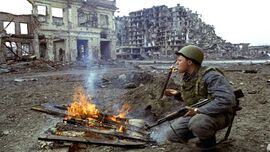
As the central power in Ulich weakened, various independence movements gained power throughout the country. The most powerful was the Balkarian independence movement in the south of Dulebia. Balkarians attempted to break free back during the civil war, and the region was unstable during the communist rule, with a lot of repressions taking place. In May 1991, the head of the Southern Region, Andrey Kovachev, declared the independent Republic of Balkaria. Most of the military within the newly-formed republic joined the protesters on the streets of Strumyan. The part of the army still loyal to Ulich barricaded in several military bases and asked for help. Beglov was forced to declare war on the rebels on 27th of May 1991. While largely successful, the short war led to some defeats of the Dulebian regular army, including the so-called Lozenets Mincer, when 370 Dulebian soldiers lost their lives in an ambush on the streets of the provincial town of Lozenets. The Republic of Balkaria capitulated in February 1992.
With Mutko as head of the government, and the impossibility to continue the reforms because of the Council of People's Representatives, Beglov was facing a dilemma. In July 1993 he removed Mutko from his post, and declared that he wants Chernyshevsky to return to his former post, to continue the radical reforms of the economy, and to hold a referendum for a new constitution in the country that would establish a presidential republic. His initiatives were declined by the Council, and his resignation was demanded. In an attempt to save the reforms and his post, Beglov made a spountanous and unprepared speech on the national TV, declaring that the Council is attempting to stop the development of Dulebia, to reestablish the totalitarian communist regime and that the citizens of Dulebia must show their support to Beglov if they want to save the liberal policies in Dulebia. The next day, Beglov personally dissolved the Council of People's Representatives, and declared Dulebia as a presidential republic. Members of the Council barricaded themselves in the parliament building in Ulich, and from there made an announcement that Beglov is attempting to destroy the Dulebian democracy. Thousands of supporters of the communist regime, criminal elements, and people who did not support Beglov, stormed the streets. The 6th Guards Division military base in Ulich experienced a rebellion, and control was taken by officers loyal to the Council. Soldiers from the base used firearms and heavy equipment to drive the unarmed police back from the parliament building and lift off the blockade, killing sixteen police officers and injuring almost one hundred. In the following days, the rebelling military armed the protesting citizens and raided several important buildings: the main television central in Ulich, the Military Medical Academy building and the ministry of interior building. Beglov took the decision to arm the police officers and bring the regular army to Ulich only on 3rd of August 1993, two days after the beginning of the public unrest. The following 7 days military and citizens clashed on the streets of Ulich, and eventually the rebels were crashed and a blockade was formed once again around the parliament building. These events remain in history as the 9-day war in Ulich and took the lives of 293 people in total. Regardless of the victory in the coup, Beglov declared that new elections will be held in the country. His rating was extremely low following the economic reforms of 1990-1992, the bloody Balkarian war, with the and the bloodbath in Ulich and his poor decisions effectively ending his political career, thus, he was forced to announce new elections to prevent a new outburst on the streets of Dulebian cities. Elections were planned for 1st of December, 1993.
Modern history
On the December elections, Beglov faced Alexey Volodin, the leader of the Dulebian communist party and the organiser of the coup. Elections were won by Volodin with a result of 65%, while Beglov managed to gather only 27% of the votes. In the following months, mostly because of public pressure, the new president reformed old communist party into a more liberal social democratic party, its constitution was reformed, various conservative members were kicked and some were even arrested, like Vyacheslav Mutko, former prime minister and close friend of Volodin. Still, the new cabinet held a number of counter-reforms, including nationalisation of some companies and facilities. On the parliamentary elections in 1995, the Socialist party of Dulebia won the majority at 62%, for the first time in the history of democratic Dulebia mass falsifications were recorded. The same year Dulebia accepted its first constitution since the fall of communism, which reformed the Council of People's Representatives into the Dulebian Veche, and established the country as presidential republic. The constitution would eventually be rewritten in 2001, further increasing the legislative power of the president and removing the term limit, and increasing the term length from 4 years to 8. Alexey Volodin has since established an authoritarian regime in the country. The president rules the country since 1993, and is currently the longest-ruling Dulebian politician since the Dulebian revolution. Numerous reforms were performed in the legislative branch to keep only loyal and system opposition parties in the Veche, and oppressive laws to counter social unrest are being introduced every year. Dulebia is currently crippled by corruption, internal instability and political oppressions.
Geography
Dulebia occupies a portion of the northeastern Cardia and southwestern Erdara, on the border between the two regions, bordering four countries—Rovina to the northeast, Lavaria to the west and a maritime border with Erjarvia to the north. The land borders have a total length of 3,784 kilometres (2,351.2 mi), and the coastline has a length of 821 kilometres (510.1 mi). Its total area of IDK square kilometres (IDK sq mi) ranks it as the world's Nth-largest country. The most notable topographical features are the Dnistrian Plain, the Riliva Mountains, the Central Dulebian Plain, and the Hajduski Mountains. The river Dnistr runs through the middle of the country, marking the border between Erdara and Cardia. Dnistr is the longest river in Dulebian and is located mostly on its territory.
The Riliva mountains are located in the northern part of the country, on the border with Rovina. The mountainous southeast has one distinct alpine range—Hajduski, which are separated by the river Dnistr from the higher and less extensive Riliva Mountains to the North. Skoparnik, at 2,216 metres (7,270 ft), is the highest point in Dulebia, and the Karsk sea coast is the country's lowest point. Plains occupy about two-thirds of the territory, while plateaux and hills occupy 21%. Most rivers are short and with low water levels.
Climate
Considering its small area, Dulebia has variable and complex climate. The country occupies the southernmost part of the continental climatic zone, with areas in the west falling within the Karsk climatic zone, while in some southwestern and southeastern zones forests evolve into steppes. The continental zone is predominant because continental air masses flow easily into the unobstructed Dnistrian and Central Dulebian Plains. The influence of the continental climate is stronger during the winter, and as a result it produces snowfall; the White sea influence increases during the second half of summer and produces warm and dry weather. Dulebia is subdivided into five climatic zones: continental zone (Dnistrian and Central Dulebian Plains and the Mursk Plateau); transitional zone (Pokrovsk Plateau, most of the Bratsk Plateau, the lower Sub-Riliva valleys); continental-Mediterranean zone (Spassovsk valley); Karsk Sea zone along the coastline with an average length of 20–40 km inland; and alpine zone in the mountains above 1000 m altitude (central Hajdushki Mountains, Riliva and Verhoyansk Mountain Plateau.).
Despite the large distance, the most important climate-forming factor is the White sea. the circulation of cyclons and anticyclones in its northeastern and eastern waters are an example, as they bring cool and rainy weather during the summer season and relatively mild weather with abundant snowfall in the winter season. The influence of the Karsk Sea is strongest in the southwestern parts of Dulebia, mainly through the Karsk cyclones. The Riliva and Verhoyansk mountains isolate the country from the hot areas to the east, while the Haydushki block the way for rainclouds to the Tayari Lowlands to the south.
Another important factor is the relief. The Dulebian mountains and valleys act as barriers or channels for air masses coming from the north and east, causing sharp contrasts in weather over relatively short distances. The Riliva Mountains form a barrier which effectively stops the cool air masses coming from the north and the warm masses from the south, while the Verhoyansk mountains also block the movement of hoter air masses from east to west and Karsk masses from west to east. The barrier effect of the Riliva Mountains is felt throughout the country: on the average, northern Dulebia is about one degree cooler and receives about 192 mm more rain than southern Dulebia.

The mean annual temperature in Dulebia is 11.1 °C and varies from −2.2 °C at the nation's highest peak Skoparnik to 13.9 °C at the cities of Spassovsk and Chervontsy in the southwestern Dnistrian valleys. The average temperature in the Dnistrian Plain is 11.4 °C, in the Mursk Plateau – 9.9 °C, in the lower mountains – 8.1 °C and in the higher mountains – 2.4 °C. The highest absolute temperature was measured at the town of Listvyanki in 1943 – 46.4 °C; the lowest absolute temperature was measured at the town of Vrana in 1954 – –35.3 °C. The highest temperature in the lowlands and the hilly regions is in June, while in the higher mountains the warmest month is August. The lowest temperature is measured in January and February, respectively. Many valleys experience regular temperature inversions and fogs in winter. The country's lowest absolute temperature was measured during inversion in the western Dnistrian valley.
The average precipitation in Dulebia is about 720 mm. However, it is relatively uneven, the amount depending on both terrain and season conditions. In northern Dulebia, the highest precipitation is in winter, while in southern Dulebia it is in May-June. The average amount of precipitation also varies in term of altitude – from 350–850 mm in the plains to 850–1400 mm. The lowest mean precipitation is in the southwestern Dnistrian valley and the Mursk Plateau (350 mm) and in the area around the town Murovanka (500 mm); the highest rainfall falls in the mountains – the Petrohan Pass in the eastern Hajduški Mountains and Andreevo Pass in the Riliva Mountains. The highest annual rainfall was measured in 1975 in the upper valley of the river Peshterska in the eastern Riliva Mountains (2431 mm); the highest daily rainfall was recorded in Chervontsy in the Karsk sea (342 mm) in 1915. The total annual amount of the rainfall is 318 billion km3; of them, 70% evaporates, 20% flow into the rivers and 10% soak into the soil. Most of the country is affected by droughts in June and August. The snow cover lasts from 20–30 days in the lowlands to 9 months in the highest mountains
| Climate data for Dulebia (records from all meteo stations) | |||||||||||||
|---|---|---|---|---|---|---|---|---|---|---|---|---|---|
| Month | Jan | Feb | Mar | Apr | May | Jun | Jul | Aug | Sep | Oct | Nov | Dec | Year |
| Record high °C (°F) | 29.6 (85.3) |
27.8 (82.0) |
37.7 (99.9) |
38.1 (100.6) |
39.9 (103.8) |
43.1 (109.6) |
44.2 (111.6) |
46.4 (115.5) |
39.7 (103.5) |
39.2 (102.6) |
37.7 (99.9) |
25.8 (78.4) |
46.4 (115.5) |
| Record low °C (°F) | −35.3 (−31.5) |
−26.9 (−16.4) |
−21.7 (−7.1) |
−12.8 (9.0) |
−7.6 (18.3) |
−5 (23) |
−2.7 (27.1) |
−0.6 (30.9) |
−7.1 (19.2) |
−12.8 (9.0) |
−19.9 (−3.8) |
−22.2 (−8.0) |
−35.3 (−31.5) |
| Source: Gosstat | |||||||||||||
Biodiversity
From northwest to southeast the country is clad sequentially in coniferous forests (taiga), mixed and broad-leaf forests, grasslands (steppe), and dry arid semi-desert (the eastern Verkhoyansk Plateau), as the changes in vegetation reflect the changes in climate. Dulebia has one of the biggest forest reserves in the area.
The interaction of climatic, hydrological, geological and topographical conditions has produced a relatively wide variety of plant and animal species. Dulebia's biodiversity is one of the richest in Erdara. It is conserved in six national parks, 15 nature parks, 10 biosphere reserves and 565 protected areas. Overall, 56,493 plant and animal species are present. Larger mammals with sizable populations include deer, wild boars, jackals, brown bears and foxes. A third of all nesting birds in Dulebia can be found in Lozenets National Park, which also hosts Arctic and alpine species at high altitudes. More than 37% of the land area is covered by forests. A total of 107 animal species have been included in the Red Data Book of Dulebia as of 1997 and are now protected. Dulebia is home to six recognised world heritage sites.
Dulebia is raked high in the Berean Environmental Performance Index, but scores last in the region in air quality, with particulate leves in the eastern part of the country being the highest in the region. Air pollution is caused by the huge number of outdated powerplants and factories, many of which lack even basic filters. Due to its geographic location, locked by mountains from three sides, and affected by a number of coal mines, factories, powerplants and automobiles, the city of Vishnevsk is notorious for being the most polluted city in the region, and poses a threat to the ecosystem of the Riliva mountains, both in Dulebia and in Rovina.
Politics
Governance
President of Dulebia
Since 1993
Prime Minister of Dulebia
Since 2004
Dulebia is ruled as an unitary semi-presidential republic, according to its constitution. The position of president is the most powerful executive position in the country, being simultaniously the head of state, commander-in-chief of the armed forces, and the guarantor of the Dulebian constitution. The president of Dulebia is elected directly on national elections held once per eight years, with the last being held in 2018. According to the constitution of 1990, the president was elected for a term of four years and could only serve two terms in office. However, after the ammendments of 2001, the limit of presidential terms was eliminated, while the duration of a single term was increased to eight years. The second most powerful position in the country is the one of the prime minister, who serves as the head of government, and is elected once every six years on a national voting. The primary duty of the prime minister after his election is to form the government of the country, which is then proposed to the president, who can appoint them after gaining consent from the Veche, the state parliament. The political system of the country consists of three branches: the legislative, executive and judiciary branch, which perform different roles in the governing system of the country.
Dulebia positions itself as a multi-party representative state. Its constitution provides the needed possibilities for direct democracy: freedom of protests, meetings, petitions, and referenda. The country enjoys an universial sufferage available for citizens at least 18 years old. The legislative branch consists of the Dulebian Veche - an unicameral parliament comprised of 450 seats and serves as the gathering point for political parties in the country. The Veche is given the ability to adopt and enact laws, declare war, deploy troops outside of the country, approve or dismiss international treaties and appoint elections. Furthermore, the power of the purse, as well the power to call of impeachment of the president or dissmissal of the cabinet of ministers is also granted to the Veche by the constitution. The deputies of the Veche are elected during popular votes for a term of four years, and can be either independent or members of a political party. Political parties must be registered and approved by the state to participate in elections.
The executive branch of the country consists of the president, who enjoys the biggest concentration of power, the prime minister, and the cabinet of ministers formed by the prime minister after his election and approval by the president on the consent of the Veche. The primary task of the government is to administer and enforce national laws once the latter have been passed by the Veche. Members of the cabinet can be aligned to different political parties or independent, and are appointed by the president on recommendation of the prime minister. Once appointed, they can no longer participate in the legislative branch of the country.
The judiciary of the country, according to the constitution, serves completely independently from the other two branches of power. The Constitutional court of Dulebia is the highest level of the judiciary in the country, with the Supreme court serving as the court of last resort in the Dulebian administrative law, and smaller tier regional courts dealing with cases on regional and local level. Judges of the Supreme court are appointed by the Veche upon recommendation by the president. The judiciary is the source of law in the country.
Since 1993, Dulebia is suffering from deterioration of the democratic governance in the country. Flawed by reduced media independence, stalled reforms, abuse of authority at the highest level and increased dependence of local administrations on the central government, as well as direct violations of the freedom of speech and the principles of direct democracy, granted by the constitution. This has resulted in reclassification of Dulebia first to flawed democracy in 1994, and later to hybrid regime and authoritarian regime in 1998 and 2001, respectively. Dulebia ranks last in the democracy index in Berea, and 17th from 22 countries worldwide, with the tendency of deterioration of the power continuing into the second decade of the twenty-first century.
Administrative divisions
According to its constitution, Dulebia is administered as an unitary state. The country is divided into 12 regions, or oblasts (Dulebian: область), subdivided into 103 districts, or raions (Dulebian: район), and one district with national significance, where the national capital is situated. Some regions are named after their administrative centers, other received their name after the historical region they are situated in. On official level, all regions enjoy a similar amount of autonomy, however, the national capital and the Balkarsk oblast in the southern part of the country have somewhat increased autonomy, with the latter given the ability to elect its chairman of the regional assemby. The regional legislative power is represented by regional assemblies (Dulebian: Региональные собрания), members of which are elected once every four years, and a chairman of the council, who is being appointed by the president (with the exception of the Balkarsk oblast). Each region is subdivided into raions, and every raion is administered by a local district council (Dulebian: районное собрание), members of which are elected on a yearly basis, while the chairman is appointed by the chairman of the regional assembly. Ulich, the national capital, is a notable exception from this rule, as its city council also serves as district council, and the chairman of the council is elected by the citizens of the district, serving parallelly as mayor of the city.
Setlements within the country are divided into several types, the main subdivision being among urban and rural types of settlements. Urban settlements are further divided into cities (Dulebian: город) - settlements with a population of over 50,000 people, and urban-type settlements (Dulebian: поселок городского типа, п.г.т.), an administrative division originating from the Soviet rule, and used to classify settlements with a population between 15,000 and 50,000 people. Rural settlements consist of villages (Dulebian: село) and settlements (Dulebian: поселок) - a generally used term to define small villages of less than 1,000 inhabitants. Depending on their significance within the country, major cities receive a degree of autonomy and self-rule. Still, all administrative divisions remain extremely dependent on the administartive centre, based in Ulich. Regions are forced to send all the generated profit into Ulich, where it is redistributed among regions. The amount of funding a region receives from the centre often does not match the output of the region in the economy of the country. This mechanism is often considered to be a part of the pyramid of power within the country: too oppositional regions can receive less state funding which leads to lowering of the standards of living within such regions, allowing the administrative centre and the legislative power of the country to control the opposition within regions of the country.
|
|
Foreign relations
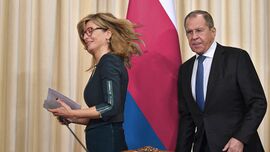
-Historic overview of Dulebian relations with great powers-
-Dulebian participation in intergovernmental organisations and its role in them-
-Dulebian foreign policy with its neighbours-
Law and law enforcement
The criminal justice system of Dulebia consists of three major components, each fulfilling its separate function: the judiciary, law enforcement and penitentiary. The judiciary in Dulebia acts as a separate branch within the power structure of the country, while the law enforcement and penitentiary components are under the control of the executive branch, specificaly the Ministry of Justice of Dulebia, as defined by the constitution of the country. The main tasks of the criminal justice system are to protect the civil law and order in the country and to enforce the laws within the boundaries of Dulebia. As claimed by the constitution of the country, all actions performed by its justice system are based entirely on the rule of law.
The law enforcement system in Dulebia consists of several governmental organisations and agencies, each perfoming its specific role, with examples of overlapping jurisdiction between separate agencies being very common. The Dulebian police serves as the basic law enforcement actor in the country. It operates under the Ministry of foreign affairs, and acts as a centralized structure within all regions of the country. The current structure is almost identical to the soviet-era militsiya, with only minor changes applied to the organisation in the early 1990s after a series of reforms of the executive branch of power.
Apart from the police, several state organisations perform law enforcement while being answerable only to the President of Dulebia, those being the National Security Service (Dulebian: Служба национальной безопасности, СНБ) and the National Investigative Bureau (Dulebian: Национальная служба следственных работ, НССР). Both agencies possess the authority to perform law enforcement within the country and to possess their separate law enforcement agents. The National Security Service, apart from performing law enforcement tasks, is also responsible for counter-intelligence, border control, internal surveillance, counter-terrorism and protection of high-ranked officials, and is the direct successor of the MGB, the soviet state security organisation. The National Investigative Bureau's task is to perform control over other law enforcement agencies and engage in anti-corruption activities.
Apart from that, the Dulebian National Guard, which is a branch of the Dulebian armed forces, can engage in law enforcement activites within the country even in times of peace and is answerable only to the President of Dulebia. National Guard soldiers can be used as riot police. Until 2010, law enforcement operations of the National Guard could be conducted only under state of emergency or martial law after acceptance by the Dulebian Veche. After a number of reforms of the structure, the President no longer needs sanction by the legislative branch and a declaration of a state of emergency to use it as a law enforcement unit.
The penitentiary system of Dulebia is responsible for the correction activities within the country. All correction activities are performed by the Penitentiary Service of Dulebia (Dulebian: Служба исполнения наказаний Дулебии), which is under the direct control of the President of Dulebia. The service is a successor of the soviet agency of the same name, however, unlike its predecessor, it is a separate agency under the direct control of the head of state rather than a subsidiary of the state security organisation. Its main functions include the detention of suspected and convicted persons and the operation of state detention facilities. Overpopulation of detention facilities in the country is a major problem, on par with a high incarceration rate. Dulebia is one of the top-three countries in the world with the highest percentage of prisoners per 100,000 citizens.
Military
This article is actively undergoing a major edit for a short while. To help avoid edit conflicts, please do not edit this page while this message is displayed. This page was last edited at 09:45, 28 May 2022 (UTC) (2 years ago). Please remove this template if this page hasn't been edited in several hours. If you are the editor who added this template, please be sure to remove it or replace it with {{Under construction}} between editing sessions. |
"The Dulebian military is divided into the Ground Forces, Navy, and Air Force. There are also two independent arms of service: Strategic Missile Defence Force, and the Airborne Troops. As of 2017, the military comprised over 76,000 active-duty personnel, the nth largest in the world. Additionally, there are over 185,000 reservists, with the total number of reserve troops possibly being as high as 1 million. It is mandatory for all male citizens aged 20–32 to be drafted for a year or two of service in Armed Forces. Dulebia's mechanised force is one of the smallest in Berea, consisting only of 320 armoured vehicles. It is worth to mention, however, that the vehicles operated by Dulebia are one of the most expensive in the region, and also are often named to be among the most effective in the world in comparison to their relatively low price. The country is also capable of producing different types of armoured vehicles, like APCs, IFVs, and its automotive industry erected a large variety of light combat vehicles, ranging from simple light mobility vehicles and up to heavy wheeled tank destroyers. The country has a large and fully indigenous arms industry, producing most of its own military equipment with only a few types of weapons imported. It has been one of the world's top suppliers of aircraft since 2001, accounting for around 30% of worldwide combat aircraft and exporting them to about x countries. Domestically produced aircraft have proved to be one of the leading designs in Gaia and were used with significant success during the WAR WITH KRUMLAU, scoring an impressive amount of air kills. The Dulebian government's official 2014 military budget is about Ћ53.08 billion (approximately US$23.80 billion), the nth largest in the world. The official budget is set to decrease to Ћ46.6 billion (approximately US$20.9 billion) by 2025. As of 2018, Dulebian military budget is lower than any other Berean nation." - shortening of this section
-brief description of branches-
-couple of words on the military industry-
Capital punishment
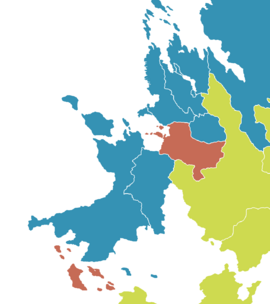
Capital punishment remains a legal penalty in Dulebia since 2001. The sentence is carried out as an execution by shooting, by single shot or firing squad. Dulebia is the last country in Berea to have been reported to enforce capital punishment upon its citizens, with the last case taking place in 2019, at least according to official records. Capital punishment within the country can be enforced on several occassions: drug trafficking, especially violent murder under aggravating circumstances, war crimes against citizens of the country, terrorism or murder of law enforcement agent.
Capital punishment has become a legal penalty only during the Soviet rule. In Imperial Dulebia, capital punishment hasn't been established as official sentence, instead corporal punishment was used, with variations of its execution, often leading to the death of the person on which it was enforced. Death penalty via shooting became official during the rule of Lavrenty Konev, and was added to the criminal code of the country in 1929. After the dissolution of the Soviet state, two attempts to outlaw capital punishment were performed by the Beglov administration in 1990-1991, with the former failing to gain acceptance within the legislative power of the country, and the latter ending up as a compromise, with the establishment of a moratorium on death penalty within the country. During the constitutional ammendments of 2001 performed by Alexey Volodin, one of the questions asked on the national referendum was whether capital punishment should be returned to the criminal code of the country, remain under moratorium or be abolished completely, with the results showing 79% support among citizens to restore capital punishment within the country for "grave crimes", with the definition behind this article remaining unexplained by the criminal code of the country until 2005. Today, Dulebia remains the last country in Berea to enforce capital punishment on a regular basis, with the most cases being in the sphere of drug trafficking. The reestablishment of the penalty was a factor for the Berean country sanctions enforced on Dulebia between 2001 and 2007, and still proves to be a problem when the country attempts a closer integration with Telmeric countries like Mascylla.
Economy
Dulebia has an upper-middle income mixed economy. The country is particularly rich in natural gas and coal and has notable amounts of oil. The geographical and geopolitical location of the country also benefits its economy greatly. It has the 9th largest economy in the world by nominal GDP and the 8th largest by purchasing power parity (PPP). Since the fall of the socialist regime, the instability in the 1990s and the troublesome early 2000s, higher domestic consumption and growing political stability have bolstered economic growth in Dulebia. Still, even today the economic growth of the state is highly dependant on fossil fuel price. Compared to 1993, Dulebia's GDP per capita has experienced an almost 193%, rising from 7,180$ in 1993 to 20,993$. Dulebia's economy experienced a significant boom in the period between 2003 and 2009, mostly fueled up by rising oil and natural gas prices, with the annual economic growth reaching 21% in 2007, considered a peak year. Since 2009, with prices on energy carriers lowering significantly, Dulebian economic growth slowed, stabilizing at 3% annual growth in 2015. Currently, the country experiences another, a lot smaller economic boom, with the annual growth in 2017 set at 4%, rising to 6% and 7.2% in 2018 and 2019, respectively, and with an expected growth of 8.9% in 2020. The current growth is primarily driven by exports of machinery, energy and fossil fuels, as well as the rising domestic market. The average salary in Dulebia has experienced a similarly rapid growth in the past 30 years. Just after the collapse of the People's Republic of Dulebia and during the financial crisis of 1991-1993, the average salary was set at 284$, the lowest in the region. By 2018, the official average salary is estimated at 951$, the minimal wage is 385.75$. The Dulebian government has set a living wage for its citizens at 211.50$, the minimal amount of money a Dulebian should earn to keep himself healthy and with decent working capacity. While according to national law every citizen must earn no less than the minimum wage, reports from numerous villages across the country suggest that at least 5.2% of the population earns less than the living wage. Officially, 11.2% of the Dulebians in working capacity age were living below the poverty line, while in total 18,7% of all citizens were living in poverty as of 2009. The Dulebian government since reported decrease by 7.3%, although it is worth mentioning that in 2016 the poverty line was decreased from 275.14$ to the living wage minimum, and further to 199.4$ in 2017. Official unemployment in Dulebia stands at 4.3%. Gosstat states that 36.5% of the working population has more than one full-time workplace. The middle class in Dulebia is fairly smaller than the one of its neighbours, at 8.9%. It is growing ever since 2017 with a stable rate of 0.6% annually. The economic development of the country has been uneven historically and geographically. The industrialization of the country began in late 18th and early 19th century, however, it affected only its western part during the Dulebian Empire, while the country's east was not densely populated, and focusing in agriculture. Most societies in the eastern part of the country were considered agrarian up until the early 20th century. The rapid industrialization was mostly aimed at forming a manufacturing force in the east while transferring agriculture to the wealthier west and using it as the face of the country on the international arena. The result is that today the east is almost exclusively focused on mining and manufacturing, while the west is focused on trade, agriculture and to a lesser extent on manufacturing. Ulich is the financial heart of the country and contributes greatly to its GDP. At more than 7 million inhabitants, Ulich is the biggest city in Dulebia and one of the biggest in Erdara, and a world city and economic hub.
Inequality of household income and wealth is a major problem in the country. Dulebia is ranked relatively low by the Gini index compared to its Berean neighbours, with a stable increase of inequality. Another problem is the modernisation of infrastructure, especially in the eastern areas of the country. While the government has put massive invests in the modernisation of the manufacturing industry in the west of Dulebia, the east still relies on outdated equipment, some of which produced in the 1960s. Dulebia ranks as the most corrupt country in Erdara, according to the Corruption Perceptions Index. Corruption in Dulebia is perceived as a significant problem impacting all aspects of life, including public administration, law enforcement, healthcare and education.
Dulebian economy focuses heavily on fossil fuel extraction and processing, production and export of electricity, automotive, heavy, aeronautical and electrotechnical industries, chemical and woodwork industries, light industry and tourism. Energy carrier exports count for 39.5% of the country's GDP, forming the biggest sector of its economy.
Dulebia has developed automotive industry, with three big manufacturers exporting vehicles worth $54 billion annually. The country has one of the most developed aeronautics and space industry, exporting the biggest amount of passenger aircraft in the world, the third-biggest amount of military aircraft, and being the fourth-biggest supplier of spaceship parts, holding the leadership in liquid-fuel rocket engines. Dulebia possesses the biggest factory in Berea producing and processing liquid oxygen-based rocket fuel.
Resource export is a focus industry for the country. Dulebia has one of the best-developed gas transition pipeline networks in Berea. Apart from gas and oil, coal, lignite, steel, and lead form the biggest sectors of the mining industry. Dulebia also produces and exports chemicals, focusing on pharmaceuticals, household chemicals, paint and synthetic fibre.
Dulebia is an associate partner of the Berean economic Union since 2004. Between 1996 and 2002, Dulebia acted as an observer state, but since opening its economy it experienced general warming of relations with its northern neighbours. Dulebia signed the 2008 Ulich Treaty with the Berean Union member states, giving it certain privileges on the Erdaran single market. Still, corruption does not allow Dulebia to become a full member of the Union. The Erdaran Union is currently the most important trade partner of the country, receiving more than half of its exports, especially in the energetic export. Dulebia has historically been in warm relations with Cuthland-Waldrich, the latter relying on Dulebia's nature gas imports. Even since the fall of the socialist regime in Dulebia, the two countries struggled to keep their trade partnerships with each other. Hytekia is the second-biggest export market for Dulebia, and is placed third by the size of imports into the country. The Dulebian national currency is the Chervonets (dul. червонец, symb. Ћ). It is regulated and controlled by the Tsentrobank (dul Центробанк), the central bank of the country, situated in Ulich. Since 2015, in an attempt to fight growing inflation, the currency was set in free float, pegged again in 2019 after the central bank naming the initiative "unsuccessful".
Corporations
During the Soviet rule, the country focused mostly on heavy industry production, which can still be seen today in its economy. Dulebia has three major automotive companies, which are one of the biggest in Berea. Dulebia is also famous for the production of a number of high-technological goods, most notably aircraft, rocket engines, and military equipment. With a raw resource extraction-based industry, it is not a surprise that Dulebia also has a number of major companies in the sphere of fossil fuel extraction, processing, and transportation, most notably in the sphere of natural gas and coal, as well as the extraction of various ores, like steel and non-ferrous metals like copper. Dulebia has a very developed chemical industry by Berean standards, and produces a wide arrange of domestic and international pharmaceutical products, specializes on household chemicals and rubber processing. Since recently, the IT sector of the Dulebian economy saw a rapid growth under state stimulation, with the most notable example being Quantech, the biggest software company in the country.
Currently, the most famous and worldwide-recognized companies and brands of the country include AvtoVAZ, MAZ and UAZ in the automotive industry; NAA in the space and aeronautics industry; NefteKhim Gorlovets in the chemical industry; VishUgol, NovaTEK Naftogaz and KamGazKom in the fossil fuel extraction and processing industry; StumStal in metallurgy and Skytrain, the flag carrier of the country. All Dulebian companies trade on the DXI stock exchange, based in Ulich, as well as on various international bourses throughout Berea.
While the Dulebian economy is considered to have significant potential, and is one of the most developed ones among developing countries, the internal factors of the country, such as mass corruption and fraud, lowers the economic growth of Dulebia. Specialists agree that the only way to increase the output of Dulebia on the global market and improve its industrial health are long-term economic reforms and change of the ruling policies, as well as a reform of the judiciary of the country. For the time being, however, Dulebia remains relatively deprived of the attention of foreign investors, and investments in the country were rapidly decreasing since the early 2000s, only starting to grow again in 2019. Monopolization of the key sectors, protectionist policies and corruption, as well as instability within the country itself and arbitrariness of its security officers are among the main reasons for the relatively unsuccessful Dulebian economy and the stagnation of the country in the twenty-first century.
Energy and resources
Dulebia is the 6th largest electricity producer in Erdara and the 4th largest renewable energy producer, the latter because of the well-developed hydroelectricity and thermal electricity production in the country. Large cascades of hydropower plants are built in along river Dnistr. Its central area is rich on thermal sites, and while most of them are used for recreation activities, some of the major ones are also used to produce electricity, placing Dulebia on the 4th place in Erdara in the list of thermal energy producers. The Gorlovka Basin and the southern Mursk Plateau are rich on natural gas, which the country actively exports to Berea and Pamira.
Dulebia was the first country in the Berea to develop civilian nuclear power and to construct Berea's first nuclear power plant. Currently, the country is the 3rd largest nuclear energy producer, with all nuclear power in Dulebia being managed by EnergoAtom State Corporation. The sector is rapidly developing, with the aim of increasing the total share of nuclear energy from current 21.9% to 30% by 2035. The Dulebian government plans to allocate Ћ88 billion ($35.87 billion) to a state program dedicated to the next generation of nuclear energy technology. About Ћ96 million ($42.7 billion) was allocated from the state budget to nuclear power and industry development before 2015. As of April 2019, Dulebia possesses 8 nuclear power plants, 11 hydropower plants, 4 thermal power plants, 15 coal power plants, 7 oil powerplants, 3 photovoltaic power stations and 2 wind farms. In addition, the government plans the reconstruction of 5 artificial lakes to hydropower stations until 2030, for which Ћ67.9 billion ($30.2) were invested from the budget for the next 5 years. Dulebia also plans the construction of 2 new nuclear powerplants near Spassovsk and Komsomol'sk-na-Ugre together with specialists from Erdara. The planned power outcome of the stations is placed at 852 MW and 570 MW, respectively, and will supply the TBN sea coast with additional power that is often in shortage in the tourist season. Around 15% of the electricity produced at the new plants is planned to be exported. The construction is planned to begin in 2028, and the annual prize will be around $2.9 billion and $2.5 billion respectively, 78% of which will come from the state budget. Dulebia plans to make energetic deals with its Erdaran Union partners in the next 6 years.
Dulebia is a member of the Berean energetic union since 2004. In October 2005, Dulebian president Alexey Volodin signed the Erdaran 2030 program, according to which the share of renewable energy sources of every member country must reach 50% by 2030. Dulebia has been rapidly developing the renewable energy sector in the late 2000s' and 2010s', and reached its targeted 40% in 2016. Currently the country is the 4th largest renewable energy producer, and widely exports it abroad, while non-renewable energy is mostly used domestically. The Dulebian government created a number of state programs in the early 2010s' to support the construction of new renewable energy powerplants both by domestic and foreign companies. The 2016 Treaty of Chervontsy allowed foreign companies to construct, maintain and operate green powerplants within the country tax-free for the first 3 years of operation, with the Dulebian government subsising the construction. Foreign-constructed green powerplants can be operated completely by foreign companies and are not required to hire Dulebian specialists (although companies that hire Dulebians are freed from taxes for the first 5 years of operation rather than 3). Since Dulebia is a major electricity exporter, the government has set a goal to reach 75% of renewable energy sources by 2040, while additionally increase the power output of the country to 311 TWh according to the 2040 Program. With a gross total energy production of 215 TWh, Dulebia's total consumption in 2018 was 161.25 TWh, or 75% of the energy production. Of those 41% is consumed by the country's industry, 28% by households, 21% by traffic, and the other 10% by minor consumers.
Dulebia holds one of the greatest reserves of mineral resources in the region. While some are easy to access, Dulebia's gas reserves are situated in swamp areas making them rather expensive to mine. The country is most abundant in mineral fuels. The most developed fields lie in the northern part of the country, in the Gorlovets Basin, and in eastern Riliva mountains, especially around the city of Vishnevsk. Smaller deposits are found throughout the country, most notably in the western Riliva, the Haydushki mountains, the Verkhoyansk Plateau and around the city of Volynsk. Significant oil reserves are found in the Dravichi Gulf. Scientists claim that the Karsk sea holds a significant amount of oil and potentially gas, however those deposits are only yet to be investigated. Natural gas, a resource of which Dulebia holds around eight percent of the world's reserves, can be found in the swamps of the Gorlovets basin and southern Mursk Plateau. Major coal deposits are located in eastern Riliva around the city of Vishnevsk, with some smaller deposits found around the city of Strumyan in southern Dulebia. Southern Dulebia also holds the country's biggest iron-ore reserves, and the only tin ore reserve in the area. Western Dulebia, while being relatively flat, still has some reserves of graphite, sulfur, asbestos, magnesite, and granite. Minor polimetallic ore reserves can be found in the Riliva mountains and in central and western Dulebia.
The Karsk sea coast is rich on raw materials such as potassium salts and halite, chalk, and holds minor reserves of phosphorites mostly situated on the Ohotsk islands. Dulebia has the biggest percentage of farmable lands in Berea, with 42% of the land used for crop farming and cultivation, 18% are used for cattle breeding and 37% are covered by woods, with the rest of the land used for other purposes. The country is one of the biggest wheat exporters in the region, benefiting from the vast amounts of chernozem in the central part of the country, mainly on the Central Dulebian and Volynsk Plains as well as on the Mursk Plateau. The state's agriculture is government-supported with credit policies, and forms 5% of the total GDP. Dulebia's main focus is crop production, as well as industrial crops (mostly cheap maltz and tobacco) and viticulture. The country's cattle breeding potential is very underutilized, forcing it to import meat products like pork and beef, mostly from its North Telmeric trade partners. Forests cover a significant portion of the country, placing it realitevy high compared to its neighbours, and Dulebia is a major forestry products exporter in the region, focusing mostly on paper, chemicals and furniture production. Due to its ownership of the Ohotsk and St. Gleb islands, Dulebia holds the biggest economic zone in the Karsk sea, controlling a solid portion of it. Thus Dulebia is a major sea product supplier for the region, especially for its nothern neighbours like Rovina. Both fish exports and imports are constantly rising in the past decade, reaching a total share of $965 million in 2019. Telmeric countries are the biggest trade partners of Dulebia, where it exports 58% of its natural resourses and fuels, 59% of the produced food and 72% of the produced raw materials. The second-biggest trade partner is Lavaria, followed by Rovina, Valimia and Kodesh.
Science and technology
First sights of technological development can be traced back to early antiquity. Ancient Karsk tribes were known for being excellent sailors. The first public libraries and schools were built during the Cambran reign, but their real development was during the Golden Age of the Ulich state in the 15th century. It is documented that Dulebian warships used liquid fire since the 9th century CE and as late as the 14th, when it was surpassed by cannons, and its receipt vanished from Dulebian records.
Science and technology in Dulebia blossomed since the Dulebian industrial and cultural revolution at the end of the 18th century, after the formation of the Dulebian Empire. The first university was opened in Ulich in 1798. In the 19th and 20th centuries the country produced a large number of notable scientists and inventors. The Dulebian physics school began with Teodosiy Kerchevskiy, known for his works on the steam engine and the first steam car, as well as heat-distribution and thermodynamics research. Dulebia played a major role in the development of the aircraft, with the aviation pioneer Andrey Efimov building the first flyable aircraft in 1901. Gun synchronizers for aircraft weapons were also pioneered by Efimov. Dulebian scientific researches played an important role in the development of the modern tank, while the Dulebian astrophysicist Nikolay Orlov is renowned for his scientific research on black holes and quasars. Vitaliy Korolyov, a renowned Dulebian engineer, is world-famous for his works on fluid-dynamic drag and fluid-dynamic lift. He also was the chief designer of various pioneering STOL aircraft designs in the '30s. The Dulebian mathematics school was developed during the 17th century and focused mainly on non-Euclidean geometry and was heavily influenced by the Gurkhan Renaissance mathematicians. Dulebian scientist Stas Glinka is renowned for his development of the modern stability theory. In the 20th century Dulebian mathematicians, such as Boris Karachevskiy, Ivan Yusupov, and Sergey Zaytsev, made major contributions to various areas of mathematics.
Dulebian physicians like Kerchevskiy and Izmail Vitlyakovskiy are renowned for their works on the engineering thermodynamics and mechanics. Their researches practically gave birth to modern standardized engineering education and mechanics, their works are used in numerous universities worldwide. Kerchevskiy designed the first steam engine in Dulebia, and in 1854 he tested the first wheeled steam car in the country, that eventually would turn into the first Dulebian automobile. The most famous Dulebian biologist is Aleksandr Tsarskiy, known for his researches of bacteria in foods and the discovery of the Lactobacillus Balcaros in the Dulebian yoghurt in 1904.
Perhaps the biggest number of inventions of Dulebias were made in the aeronautics industry. The pioneer Andrey Efimov has designed and built the first aircraft in Erdara in 1901, he also designed the gun synchronization in 1908, effectively creating the modern dogfight concept. The Dulebian scientist Iosif Ivolzhskiy is known as the inventor of the jet engine; he also constructed the first jet-propelled aircraft in 1937. His works would later lead to the construction of the first jet fighter in history, the Konev-Ivolzhskiy KIR-1, in 1942. Dulebian scientist Igor Chernyshevskiy gave a major boost in the development of helicopters. He is the pioneer of the autogyro aircraft in the 1910s and 1920s and created a series of successful prototypes, some of which were later used in the Dulebian air force. Dulebia was the first country to pioneer the carbon fibre and other composites in aircraft manufacture, leading to the creation of a series of modern aircraft designs such as the C818 and the C878 passenger jets, and the E-24 fighters. Dulebian pioneers, inspired by the flying boat designs of the early 20th century, invented the ekranoplan semi-aircraft concept that was actively used by the Dulebian navy in the late 70s and early 80s to guard its territorial waters in the TBN sea.
Famous Dulebian battle tanks include T-26, one of the most heavily produced tank designs after the Great war, and the famous Jaguar series of main battle tanks, produced until today, which are one of the most mass-produced armoured fighting vehicles throughout Berea. Dulebia was the pioneer in the oscillating turret and early tank autoloader designs, creating some of the oldest battle tank autoloaders in history on the successful Moskit light tank series. The crisis of the late 80s and 90s left Dulebia in a situation where it often lacked money to fund the scientific industry. The economic and privatization reforms of the 90s even worsened the situation. Today Dulebia remains a pretty advanced economy, with one of the most potent aeronautics and defence industrial capabilities, but is often pulled down by internal instability and corruption. Currently, Dulebia is working on it's Joint Unit Command and Navigation (GloVNaS) system that will integrate all the Dulebian forces into a singular command mechanism. The country is developing its own fifth-generation jet fighter and constructing the biggest twin-engine passenger aircraft in the world.
Infrastructure
The location at the junction between Erdara and Cardia gives Dulebia a major position in the transport system of the two regions. Dulebian road system runs from north to south for the most part, while the east-west roads are only secondary and arterial ones.
Road freight and passenger transport constitute the largest part of transport in Dulebian at 47%. First-class roads are separated into tolled highways, regional highways, and arterials. Personal cars are the most popular type of transport, used far more frequently than public road transport, which has suffered from a severe decline. Dulebia has a very high highway and motorway density compared to the Berean average. The highway system, the construction of which was accelerated after 1968, has slowly but steadily transformed Dulebia into a large conurbation. Other state roads have been rapidly deteriorating because of neglect and the overall increase in traffic. Dulebia has developed a toll system that has sometimes been criticized for its high prices. It covers all of the Dulebian roads.
The existing Dulebian railways are out-of-date and can't compete with the motorway network. Due to this fact and the projected increase in traffic through the port of Kamianets, which is primarily transported by train, a second rail on the Dravichi-Kamianets-Spassovsk route is in the early stages of starting construction. It will connect all the Karsk shore cities of the country. With a lack of financial assets, maintenance and modernisation of the Dulebian railway network have been neglected. Due to the out-of-date infrastructure, the share of railway freight transport has been in decline in Dulebia. The railway passenger transport has suffered from a complete lack of interest, both from authorities and passengers, ever since the 1990s. The only developed rail lines are the Kamianets-Ulich-Pokrovsk-Vishnevsk fast train that is in private property. The government plans to increase the number of fast train lines by 2030 and to increase rail finance, yet for now, the rail network of Dulebia is in relatively poor condition.
The major Dulebian ports are the Ports of Kamianets and Dravichi. Kamianets is the largest Karsk sea port in terms of container transport, with almost 690,000 TEUs annually and lines to all major world ports. In addition, the maritime passenger traffic mostly takes place in Dravichi and the island port of Chervontsy. Two smaller ports used for international passenger transport as well as cargo transport are located in Spassovsk and Sinemorets. Passenger transport mainly takes place with Lavaria and Erjarvia. Air transport in Dulebia is one of the heaviest in the region, and has significantly grown since 1980. The country operates 16 international airports, placing itself in the leading positions in Gaia in terms of air transport. The state-owned Skytrain is the largest Dulebian airline. Besides from that, there are also several low-cost, regional and charter airlines, including Mura Aero, Globus, and Meridian Holidays. Skytrain is one of the biggest airlines in the world in terms of passenger traffic, and the biggest and most prestigious airline of Berea. Due to the highly developed industry, all Dulebian airlines operate mostly domestically-built aircraft.
Tourism
After the death of General Secretary Yegorov and the warming of the relations between the western world and the socialist state, Dulebia became fairly liberal and open for foreign tourists from the other side of the Iron Curtain. Unlike most other communist states, Dulebia had a very simplified visa acquirement process, and Karsk sea resorts were opened for international tourists in specialized hotels and sanatoriums where Dulebian citizens were not allowed. The cities and towns on the Karsk sea coast had high percentage of their population speak two or even three languages decently, mostly Telmeric, Lavarian and Cuthish. Since the fall of the iron curtain tourism was constantly growing, interest in the country fueled up by numerous treaties by the government to remove tourist visas for a number of countries.
Tourism in Dulebia is fueled by the rich cultural heritage and great natural variety of the country. The oldest historical sights in the country are older than 40 centuries. Tourists are attracted by numerous antique and Hesurian temples, medieval kremlins and churches, classical architecture, sea and mountain resorts. Dulebia is one of the most visited countries in Berea. Tourism counts for 11.1% of the country's GDP and is one of the strategic sectors of the Dulebian economy. Dulebia has a rather simplified visa acquirement process, where foreigners can get a one-month tourist visa only for additional payment and a small amount of paperwork which can be done at home rather than in embassies. Dulebia has also cancelled the visas for citizens of countries within BDTA and Cuthland.
The most visited destinations in Dulebia are Ulich and Kamianets, the former and current capitals of the country, and the two biggest cities, and the only world cities in the country. Ulich, the country's capital, is also one of the oldest and biggest cities in the region. Rich palaces and parks are found in the former imperial residences in its suburbs. The city is also famous for its huge gardens, former imperial parks, built along the river Dnistr. Kamianets is often nicknamed the Gate to Berea. The city is one of the oldest settlements in Dulebia, the biggest commercial port of the country, and it was the biggest town and a major port and the capital of the Kingdom of Aldena in the late Middle Ages and early modern period, and served as the capital of the Dulebian Empire between the 19th and the 20th century. With a rich history, boasting a huge number of classical architecture, many rivers, bridges, and a rare example of classical medieval city architecture in Dulebia, located in its Old town, as well as the Kremlin, the city of Konopol is the third most-visited and famous city in the country. Volynsk, situated on the biggest plain in the country, is known as the City of the Churches. It has more than 42 churches and other temples, both Ditanist and Marist, the biggest Semitarist church complex in Dulebia and the biggest Qaurena school in the country. Dravichi is the city with the biggest number of Dulebian classicism, Baroque and Rococo architecture in the country. Its development was heavily influenced by neighbouring Lavaria and Cuthland. The cities of Pokrovsk and Vishnevsk in the eastern part of the country are examples of the socialist architecture and citybuilding scholarships of the 20th century. Both situated in resource-rich areas, they experienced rapid development during the communist era, and especially Pokrovsk is currently famous as the modernist, avant-garde and brutalist capital of the country, with its Palace of Culture being the biggest brutalist structure in Berea.
The Karsk sea is warmed during the summer from ocean currents, making its coast a site for a number of popular sea resorts, like Spassovsk or Kercha, Dravichi and Chervontsy. The Ohotsk and St. Gleb islands are popular among tourists because of their warm climate, wine and ancient architecture. The northern islands of the Ohotsk archipelago are mostly closed for tourists as military bases, however, part of them is accessable for civilians, most notably the Denuclarisation monument on South Buryan island. The Haydushki mountains in the south contain popular ski resorts such as Lozenets. Famous natural destinations in Dulebia include the Ulyanovo and Gorlovets swamps, Madara stone columns, the lakes of Pip peak in Riliva, and eco-roads in the taiga forests of northern Dulebia. Other popular natural destinations include cruises in the Dnistr river, the famous Ulich metro and the Kamianets metro, 18th and 19th century churches in Zhdanovo and Nizhnyaya Sloboda, and the victory monument in Vishnevsk. In the recent years, a number of cruises started to appear in the Karsk sea. While some are held as ordinary cruises on large luxurious passenger ships, there are also a number of excusrions offering access to old Dulebian nuclear arsenal test sights on the two northern Ohotsk islands. Such cruises are strictly controlled by Dulebian navy personnel, and in some spots tourists are even required to wear protective suits. The cruise also offers diving to the submarine DPK S-551 Skat submarine, which sank in 1951 after hitting an old mine. Apart from cruises exclusively between Dulebian ports, there are also lines between Dulebian, Brillianian and Hytek Karsk sea ports. Gastronomic tourism is also very popular in Dulebia, mainly because of the wine and spirits industry of the country. Gastronomic tours are very popular in the northwestern part of the country, where most of the Dulebian premium grape sorts can be found, especially in the Karsk sea, around the city of Chervontsy, the wine capital of the country. The gastronomic tourism is rapidly growing since the 2000s, and numerous agencies specializing in it opened their offices in Dulebia in the last decade.
Corruption
Ever since the dissolution of the People's Republic, Dulebia is plagued by curription, "shadow economy", organised crime covered by government officials, controversial deals, government-controlled monopolies, money laundering and recketing. According to international specialists, in 2018 money worth of one third of the total Dulebian GDP were held in offshore bank accounts of government officials. Government officials of all ranks are often caught on corruption, with the most famous case happening in august 2017, when property worth of eleven billion was found in Dulebia and several other countries, all being possessed by the wife of the finance minister Andrey Skvortsov. Only a week earlier, on an economic summit with Erdaran partners in Kamianets Skvortsov declared that the Dulebian budget is struggling to pay even the current pensions to its citizens. The resulting scandal caused several big protests in Ulich and other big cities, however, both Skvortsov and the president Volodin declined the information, leaving Skvortsov on his post.
Specialists point out that organised crime is for the most part state-controlled. There are cases when companies were forced to pay for "protection" by the law enforcement agencies like the MGB. The state created an indigenous system of laws that allow it to perform monopoly, oppress the opposition and control whole sectors of the economy. A good example is the "Counteraction to foreign agents" law pack accepted in 2015, that, in particular, allows the government to perform protectionist policies in any sector it desires, close mass media agencies, limit the funding from abroad for politicians, and establish monopolies in any sector of the economy. The law is also viewed as discriminitive, as it limits the usage of minority languages, encourages the study of Dulebian over any other national language, and puts restrictions on foreign religion schools. Such policies result in pretty unstable economic situation within the country and lower the interest of foreign investors into the Dulebian economy. Research by independent Berean specialists points out that the country lost potential profit worth 35% of its GDP from foreign investments only in 2018 due to its poor economic policies and corruption.
According to the Corruption Perceptions Index, Dulebia ranks last in Berea. While protests against corruption appear more and more often in the recent years, their prosecution by the Dulebian authorities became more sophisticated. Political experts point out that in the past years the state tries to compromise the protesters and opposition politicians, manipulating public opinion, rather than trying to oppress them directly. Numerous reports were made that during protests professional provocators are hired by the government and infiltrated into the protesting crowds to be publically arrested afterwards to create an illusion of agressive protests both for the Dulebian citizens and for the people watching the protests from abroad. With the usage of propaganda, laws targeted against oppositionaries, and political oppression, the Dulebian officials keep lowering the tensions within the country in their attempt to stay at power.
All those factors in the end lower the quality of life in the country. Dulebia is ranked last in Berea and 15th from 22 countries worldwide in standard of living. While the country produces vast amounts of natural gas and electricity, far more than it needs, it still has some of the highest electricity and heating prices even when compared to the wealthier Erdaran neighbours.
Demograpics
| Historical population | ||
|---|---|---|
| Year | Pop. | ±% p.a. |
| 1900 | 18,932,581 | — |
| 1926 | 14,567,821 | −1.00% |
| 1940 | 20,765,239 | +2.56% |
| 1950 | 24,978,299 | +1.86% |
| 1965 | 29,128,991 | +1.03% |
| 1978 | 33,455,711 | +1.07% |
| 1990 | 36,113,801 | +0.64% |
| 2001 | 32,991,310 | −0.82% |
| 2011 | 31,894,552 | −0.34% |
| 2017 | 29,894,117 | −1.07% |
| 2020 | 30,142,866 | +0.28% |
| Data given before 1926 applies only for the Dulebian Kingdom | ||
Dulebia suffered the most from the Great war and the subsequent Civil war, losing more than four million people during the two conflicts, and half a million people suffered from the repressions under Konev. Nevertheless, the country experienced a post-war population boom that lasted from the first decade after the Civil war, and up until the 1970s during the time of economic recession, with a second wave occurring between 1975 and the dissolution of the Soviet state. The Dulebian population reached its peak in 1993, when it was almost 37 million people. Since the dissolution of the People's Republic, Dulebia suffers from a constant and uncontrolled drop of population caused by immigration, reduced birth rate, and increasing death rate mostly caused by the poor air quality and inadequate medicine in the country. Recent measures undertaken by the government to increase the birth rate via social funding and support programs proved to be successful to an extend, showing a 0.28% increase of the population of the country for the three years after the census of 2017.
Emigration remains the biggest problem for the nation, and is still being unresolved. Up to 35,000 Dulebians leave the country annually, most of them heading to countries of the Northern Telmeric peninsula, like Lilienburg, Mascylla and Temaria. Еmigration percentage is highest among the young Dulebians: young students use the opportunities granted by foreign countries to study there, later gaining visas and applying for citizenship there, never returning to the country. Among the main reasons for the mass еmigration are the low standrard of living and wages, lack of internationally-recognized education institutions in numerous sectors, low level of medicine and unsatisfaction with the ruling regime of the country. According to international statistics organizations, up to 4 million Dulebians work abroad while still living in the country; of them almost 1.5 million plan to receive visas in the countries they're currently working in and later moving there with their families. Ethnic Dulebians form a significant part of the non-native population in countries like Lavaria, Lilienburg, Mascylla; significant diaspora is also present in countries like Falland and Valimia. States that were previously part of the Dulebian Empire still have a significant percentage of ethnic Dulebians living on their territory, a notable example being Erjarvia, where ethnic Dulebians form one-fourth of the total population of the country, and Dulebian language is considered a recognised national language.
The immigration into Dulebia has seen a steady decline since the 1990s. Annually, Dulebia accepts approximately 75,000 emmigrants, most of them originating from Central Pamira. Dulebia is used as a bridge between Pamira and the more successful economically-wise Berean states, as the country offers simplified visa and citizenship acquisition procedure to the former and supports somewhat friendly diplomatic relations with the latter, with its citizens receiving significant simplification of citizenship aquisition in the above-mentioned states.
Largest cities
Dulebia is a highly urbanised country, with almost 62% of the total population of the country living in its 20 largest cities. Dulebia is one of the most urbanised countries in the world, with only one of every four people living in settlements with population of less that 10,000 people. Such a high level of urbanisation is a result of the economic reforms of the 20th century, especially its first half. Following the collapse of the agriculture in the country and the following industrialization, a process of mass migration of peasants into cities was sparkled. The process was not controlled by the governement, moreso, until the end of the 1950s it was actually embraced and encouraged as the focus of the Dulebian economy switched to the heavy industry. The result of such mass migration was the need for the construction of standardized mass housing in its major cities, which led to the overall increase of population density in these cities. As a result of the migration, cities like Ulich and Kamianets became one of the largest and most densely populated in the world. The process of free flight is still present today: according to official sources, each year from 200 to 1,000 villages and settlements become abandonded and die, while the the largest Dulebian cities show a trend of population growth unseen in developed countries. Dulebia has four major cities with population over 1 million people living in their metropolitan area: Ulich, Kamianets, Pokrovsk and Volynsk, while Vishnevsk has a population of 992,000 people in its metropolitan area, and is expected to join the list of million-plus cities in the span of the next 10-15 years.
Largest cities or towns in Dulebia
Gosstat (2016/2017) | |||||||||
|---|---|---|---|---|---|---|---|---|---|
| Rank | Oblast | Pop. | Rank | Oblast | Pop. | ||||
 Ulich  Kamianets |
1 | Ulich | Ulich city | 5,285,000 | 11 | Spassovsk | Primosrk Oblast | 590,000 |  Pokrovsk  Volynsk |
| 2 | Kamianets | Kamianets Oblast | 2,760,000 | 12 | Moloha | Gorlovets Oblast | 568,000 | ||
| 3 | Pokrovsk | Pokrovsk Oblast | 1,103,009 | 13 | Preobrazhensk | Gorlovets Oblast | 501,000 | ||
| 4 | Volynsk | Volynsk Oblast | 1,008,351 | 14 | Ulyanovo | Pokrovsk Oblast | 440,000 | ||
| 5 | Vishnevsk | Vishnevsk Oblast | 992,000 | 15 | Lozenets | Balkarsk Oblast | 412,000 | ||
| 6 | Dravichi | Severokarsk Oblast | 892,000 | 16 | Kercha | Karsk Oblast | 376,000 | ||
| 7 | Konopol | Konopol Oblast | 799,000 | 17 | Novocherepovets | Primorsk Oblast | 323,000 | ||
| 8 | Chervontsy | Karsk Oblast | 778,000 | 18 | Vyshniy Vychok | Gorlovets Oblast | 265,000 | ||
| 9 | Strumyan | Balkarsk Oblast | 690,000 | 19 | Ahapsk | Gorlovets Oblast | 212,000 | ||
| 10 | Gorlovets | Gorlovets Oblast | 626,000 | 20 | Samarsk | Kamianets Oblast | 187,000 | ||
Ethnic groups
Dulebia is a multi-ethnic country with more than 15 different ethnicities living on its territory. Dulebians are the most wide-spread group within the country, with 73.3% of the population identifying as ethnic Dulebians or claiming significant Dulebian heritage. Ethnic Dulebians are of South Pomorian origin, and have lived on the territory of modern-day Dulebia since the late 8th century CE. Dulebians originate from the Tayari Lowlands, and have existed as a separate culture within the broader South Pomorian group since the 3rd century, when they developed an indigenous set of traditions. Dulebians within different regions of the country have experienced prolongued contact with other ethnic groups living on that territory. This leads to a phenomena where in the northwestern part of the country ethnic Dulebians share more in common with various Telmeric tribes, which is also recogniseable in their language, which shares a lot in common with Waldrich Telmeric, while in the southern part of the country Dulebians have shared heritage with other South Pomorian tribes and have been influenced by the Gurkhan language and culture, which was present in the area up until early 20th century. Dulebia has a significant Roma population of almost 180,000 people, with most of them living within the limits of the Balkarsk and Mursk oblasts.
During the 19th century, as the Dulebian empire rapidly expanded and subjugated its neighbours, the heartland experienced a wave of immigration from the frontiers of the state by people of numerous different ethnic groups. In the late 19th century, Dulebians formed only 56% of the population of the empire. Significant populations of Telmeric peoples were present, most notably Karsk Waldrich people and Erjarvians in the northern part of the Empire. On the south frontiers of the country, significant population of South Pomorians, most notably Balkarians and Murians, were present. Due to its land border with the deteriorating Gurkhanate, Dulebia became the main destination for Gurkhan immigrants in the 19th century, who preferred to settle in the Verkhoyansk region of the country, as well as around the city of Konopol. The empire also had contact with neighbouring Lavaria, and peoples of Lavarian and Eastern Cambran origin were present in the western part of the country. West Pomorian peoples from Rovina were also present in the Riliva mountains, where they formed the majority of the population in some borderland districts. The Dulebian empire was one of the most ethnically-diverse states of the early 20th century, a major factor contributing to its collapse during the Great War.
With the establishment of the socialist regime in the country, politics of oppression of minorities were initiated in order to keep them integrated with the state. National languages were no longer taught in regional schools, political activists from minority regions were frequently arrested, and politics of deportation of minority ethnicities to regions with majority-Dulebian population and vice-versa were frequent during the rule of Konev and Yegorov. While no longer being the official policy of the nation, similar actions are still frequently performed by the current Dulebian legislation and executive. National languages are still banned from usage on official level in minority regions, and such languages are not included in the school programmes in those regions, instead forcing locals to study them privately. The position of the Dulebian government towards minority languages is explained as "fear of rise of nationalism in such regions" by its official representatives, and was largely caused by the Balkarian war of 1991-1992.
Education
The Dulebian constitution grants all citizens of the country the right to enjoy free education. Secondary education is compulsory in the country. All citizens have access to free secondary education in state-operated schools and institutions. Higher education is provided free only in state institutions based on a competitive system, where only students with excellent results upon completion of their secondary education are allowed to study for free, while the state covers all their expenses arising with the process of receiving higher education. Private educational institutions are allowed to operate in the country after running through governmental accreditaion process. Such schools enjoy the freedom of using their own equipment (e.g. books) and are free to form their own programme, as long as all of these are accepted by the Dulebian government. The policy of the Soviet authority of mass education led to a very high literacy rate, which is currently at 99.2%, an absolute record among developing countries. The state provides secondary and higher education in its institutions. Secondary education in the country is provided by state schools serving different levels of the administrative divisions of the country. The process of studying in state schools is cut into two periods with a total length of 11 years: elementary education, lasting from the enrollment of a student into the school and until the completion of 4 years of study, and upper secondary education, lasting for the next 7 years. A notable feature of the Dulebian system is that all 11 years of secondary education are provided by the same institution the student enrolled in the beginning of their study. In the end of grade 11, all students must pass state examination. Exams on Dulebian language, Dulebian history, basic mathematics, and international language (students are allowed to choose one of three options: Fallish, Lavarian or Mascyllary) are obligatory for all students, regardless of the type of institution they have studied in. Additionally, each student is allowed to choose up to 4 additional subjects, depending on the requirements of the university they are planning to attend in the future.
Higher level education is, as well, either state-run or private. Each university has a degree of autonomy regarding the way enrollment of students is implemented, and some universities require additional exams to be passed in the end of the secondary education. Preliminary examination in Dulebian universities is not enforced by the state, but can be established by the universities themselves on an independent basis. Education in universities is paid, however, students with very high average grades can enroll and study for free, with the state covering all their expenses, from food and living to the university tax. Dulebian students receive student status upon acceptance in state-run and some private universities: this status allows such students to work without the need to sign contracts, instead using a simplified agreement where the state itself acts as guarantee. Due to the specific economic focuses of the country, universities focusing on natural science generally receive more state funding and offer more free places. The result is an emphasis on civil engineering, space and aeronautics, and sciences, as well as management, while often humanitarian science institutions can remain fairly underfunded. Dulebian universities offer exchange programs with various institutions in Cuthland-Waldrich, Erytheria, Lavaria, Mascylla, Melasia and Temaria among others. Some universities in the country, especially in the civil engineering sector, have contracts with Dulebian and international organisations and companies offering future employment of students with the addition of covering their expense for studying. Foreign students face a number of restrictions within the country: gaining free education is impossible, receiving student status, which grants the ability to work, is allowed only after 2 years of study in the country. The language bareer is also a significant challenge for foreigners: currently, only 2 of the top-20 universities in the country offer some of their courses in languages other than Dulebian.
The history of higher education institutions in Dulebia started with the establishment of the Histria Collegium in 1503 in the city of Histria, now Kamianets, which at the time was the capital of the Aldenic Kingdom. Similar schools and institutions flourished in the kingdom between the 16th and the 18th century, and still remain the oldest and the most prestigious in the country. The first university in the Dulebian Empire was estabished in 1727 by Peter II in Ulich, and was named the Cambro-Erytherian Collegium, an institution that later became the University of Ulich. Until 1900, there were only 18 functioning universities in the country, incomparable to the amount of students wishing to study and attend lections there. In 1803, with the educational reform, the law of the free auditors was established, allowing everyone to attend lections for small payment, while not being able to pass exams and graduate. The country saw a rapid growth of the number of its higher education insitutions after the establishment of the socialist rule in the country: between 1925 and 1955, all major cities with population over 50,000 inhabitants received their universities, or at least faculties of institutions based in neighbouring cities. The higher education system came to a decline after the dissolution of the socialist state in 1990, as the state didn't have the resources to fund the massive amount of universities, leading to the privatization or the termination of most of them.
Still, currently Dulebia has more than 700 functioning higher education facilities, both state-run and private. The amount of post-secondary education graduates is one of the highest in the world, as Dulebia annually produces approximately 29,000-36,000 graduates in comparison to its population of slightly less than 30 million people. Dulebian universities offer 3-year bachelor's degree and additional 2-year master's degree. Among the most prestigious institutions for higher education of the country are the Ulich University (ranked 29th in the world), the University of Kamianets and the State University of Pokrovsk.
Religion
According to its constitution, Dulebia is a secular state, where every citizens enjoys the right to follow any or no religion. However, in fact, on numerous occassions the Dulebian Semitarist church can serve as an instrument for the ledership of the country both within the country and on international level. Specialists claim that the integration of the Semitarist church is so deeply integrated within the state, with separate laws written only to protect this institution, that it is impossible to describe Dulebia as secular. According to independent survey of 2018, 74% of the country claims to follow a religion, with 58% of the total population claiming to follow Dulebian Semitarism, a subdivision of the Cambran Semitarist church. 6% of the country's population claims to follow Semitarism of the Nordic branch, most of them living in the northern part of the country. In addition, 4% follow Iqlad, 2.2% follow traditional Cambran Semitarism, 1.8% claim to follow various neo-paganist beliefs, and 1.4% following Erytherian Semitarism. 0.6% of the polled were undecided about their faith. 26% of the population claims to be atheist. The general trend for religiosity is that regions with higher percentage of ethnic Dulebians tend to be less religious, especially Central Dulebia, while the Karsk sea regions and especially the regions near or in the Haydushki mountains have significantly higher concentration of religious people. The survey shows that percentage of religious people among the population has grown since the dissolution of the Soviet state in the country, with a similar survey of 1994 showing that 41% of the population had identified as etheists.
Semitarism has arrived in Dulebia approximately in the 2nd century CE, while parts of the country were under Cambran administration. According to the legend, Semitarism was brought to the region by Semitarius Laurentius, who was later killed by the Cambrans in Ulbia and became the patron saint of Dulebia. Semitarism established itself as the dominant religion in the empire only under Hector in 298 CE, when it became the state religion. To the north of the river Dnistr, Telmeric paganism dominated up until the fall of the Cambran empire. Semitarism established itself as the dominant religion during the Early Medieval period, and was the state religion of both the Kingdom of Welbarians and the following Aldenic Kingdom between 4th and 10th century. Dulebian tribes worshipped a number of pagan gods unified under the term Pomorian paganism. Dulebians had only limited contact with Semitarism during their settlement in the Tayari lowlands. With the invasion of the Kingdom of Aldena, however, Semitarism slowly grew influential within the newly-formed Dulebian state, culminating with the Great Baptism of Ulich in 934. Since then, Semitarism established itself as the dominant religion within the Dulebian Kingdom, and later Empire, slowly absorbing some features of the Pomorian paganism, soon forming a separate subdivision of the Cambran branch known as the Dulebian Semitarist church. During the Late Medieval period, as the Dulebian Kingdom grew stronger, attempts to separate its church from Cambra were made, culminating with the Treaty of 1476, when the Ulich Patriarchate became an autocephalous church within the Cambran branch, gaining significant autonomy. The role of the church in the life of the state reached its peak during the late Dulebian Kingdom and the reforms of Tsar Yuri: as the monarchy in the state became elective, the Ulich Patriarch received the right to veto the decision of the Veche, thus the church established itself as the fourth branch of power in the country for two centuries. The disestablishment of this structure was one of the primary targets of Peter II during his reforms of the early 18th century. During his rule, the church lost most of its influence, the Patriarch of Ulich became appointed by the emperor, and the church itself turned into an institution associated with and deeply integrated within the state.
This integration of the church was one of the primary reasons for the repressions targeted against it during the Soviet rule in the country. As Dulebia proclaimed a policy of state atheism, numerous representatives of all religious confessions, especially the Semitarist chucrch, were arrested, and a lot of them were killed. The Dulebian government, while not outright banning religious worshipping, tried to control the religious communes within the state, often through mass repressions. During Soviet rule, all seminaries were closed, property of the church was nationalised, and religious officials became enemies of the state. A campaign against religious temples was intitiated: all temples became property of the state, and a significant number of them was destroyed, while in others the works of art were confiscated, the gold used on altars melted and reused, frescoes were covered with paint, and the buildings themselves were used for various purposes, from military equipment storages to detoxication centres. More than half of the churches in Dulebia were lost in the first decade of socialist rule, with destruction campaigns continuing up until the last years of the state, which is viewed as one of the biggest tragedies and losses of historic heritage in the history of the country. With the dissolution of the Soviet state, however, religion has seen a stable increase of interest from Dulebian citizens, and in recent years it also became a powerful tool within the hands of the ruling regime in the country.

Semitarism has historically been the most prominent religion for the country, and has always played a significant role in its history. Currently, the religion has the biggest amount of followers, with 16.8 million followers in the country. A very big proportion of the Semitarist followers claim they do not attend church, do not follow the traditions and only celebrate the most important holidays. The Dulebian Semitarist church is autonomous autocephaly within the Cambran Semitarist branch, altho in recent years the Ulich Patriarchy became acting more and more autonomous, often claiming the role of the leader of the "Pomorian Branch of Semitarism", recognised by neither of the three Semitarist sees. Dulebia uses its unrecognised status in its international politics: pressure on neighbouring states is often performed, and Dulebian officials tend to use an agressive rethoric towards neighbouring states, the churches of which decline to count themselves autocephalies of the Dulebian church. Such politics have led to numerous warns from the Holy See in Cambra, and Dulebia has already faced the risk of excommunication.
In the same time, minority religions seem to be facing more restrictions today than in the last decade. After the acceptance of the bill "against foreign agents", religion schools and seminaries, financed from abroad, became banned on official level. Dulebia has outright proclaimed some Iqladic sects, others face constant repressions from the state officials without being banned on official level. Numerous paganistic religions, especially popular in the Balkarsk oblast, are often criticized by state officials via mass media, a practice that started after the Balkarian war. Abuses of religious freedoms in the country have led to widespread international criticism targeted against its leadership, but particular actions have not been performed against the country so far.
Healthcare
All registered citizens and residents of Dulebia are provided with free and universal healthcare. They can be treated in state-run clinics or institutions, or choose among the several private clinics and hospitals throughout the country. Private healthcare institutions were illegal until 2009, before then all institutions in the country were state-owned. Healthcare and its institutions are supervised by the Ministry of Healthcare of the country, that, apart from its regular functions like oversight and administration of the system, also provides accreditation for private clinics and hospitals. Emergency services in the country are state-owned and operated: private hospitals rely on the ambulance service of the state, which can often cause problems for patients as the ambulance service is lacking and underfinanced. In order to get access to the free healthcare of the country, citizens and residents must pass through compulsory registration in the Ministry of Healthcare. Hospitals in the country are organised in accordance with the administrative structure of the country: small hospitals dealing with minor medical problems are found on district level and in most small towns, while better equipped institutions serve on regional level and in major cities. The biggest cities in the country have several institutions servicing their citizens. Major medical complexes that can deal with the widest scope of medical problems, however, can be found only in the three largest cities of the country, forcing residents of the periphery of the country to go there to get advanced medical treatment.
Despite the improvement achieved in the last decades, the healthcare in the country is still ranking among the last in the region. Among the most serious problems are lack of funds for district-level hospitals, underfunded emergency services, lack of essential equipment in most regional-level hospitals, poor working and treatment conditions in hospitals outside the major cities, low salaries for medical personnel, lack of interest among citizens for career in the medical sector, and unsuccessful reforms of the government among others. In order to cut spending on healthcare on regional level, a common practise in poorer regions of the country is to shut down town and district hospitals and relocation of personnel towards region-based ones, leading to the lack of any healthcare for the people in towns and villages, who often cannot afford to even travel to the major cities of their region, where hospitals are based. Another major problem is lack of proper education among the young regarding sexual relations. This ignorance has led to an uncontrolled HIV epidemic in the country starting in the 1990s and continuing even today. It is still largely ignored by the state, and it is not uncommon to see representatives of the power deny the existence of such disease on official level through mass media. Because of this, Dulebia has the highest amount of HIV-positive people per capita in Berea and one of the highest in the first world. The lack of finance for the emergency services, especially on district level, has led to the deterioration of the abovementioned institution, to a point when some areas of the country completely lack any equipment in their service and rely on higher-level institutions, or are forced to improvise to provide the service they are assigned to. All these factors have led to the dramatic increse of the death rate in the country, and contributes to its shrinking population in the past two decades. Various attempts to reform the system have been initiated in the last five years, and a trend of improvement became visible in the past two years, when the death and birth rates finally equalised. Yet, the healthcare system of the country needs a lot of improvement.
Culture
Modern Dulebian culture is a mix of various customs and traditions of peoples that existed on the territory of the country throughout its history. Semitarist traditions tend to be the dominant factor in the modern culture of the country, due to the fact that Semitarism is the dominant religion of the Dulebian people. Yet, due to the prolongued contact with customs of both Nordic and Pamiran origin, even Semitarist customs have evolved throughout the centuries, to a point where some experts claim Dulebian Semitarism to be a part of a separate branch of the religion. Some customs predate even the Cambran empire, having originated from the Foranic tribes of Early Antiquity. Such example is the Kupalov Den' (Kupala Day), a holiday celebrating the summer solstice, as well as Kukerov Den (Kuker's Day), ritual fire dance and carnival comemorating the beginning of summer. Several traditions are included in the list of world heritage.
Troughout the Middle Ages most of the works of art in the country were centered around religion: frescoes, temples, and especially icons were especially popular during the Dulebian Golden Age of the 14th century. After the westernization of the country, western styles of art became widespread. During Soviet rule, Dulebia developed its unique style of art and architecture, for example brutalism, constructivism, and developed the ideas of early 20th century surrealism in art. Dulebian music originates from Pomorian folk traditions, and has evolved throughout the centuries, culminating with military chorus music of the Soviet era, and modern Balkarian pop-folk music.
Art
The earliest type of widespread art on the territory of the Dulebian Kingdom was on religious tematics. Inspired by the works of art of the neighbouring kingdoms-successors of the earliest Barbaric states of the Dark Ages, Dulebia developed its own school of icons and frescoes, very similar to the ones produced in the Lavarian Kingdoms in Cambra, with which Dulebia had close contact. Unlike the Cambran icons, however, Dulebian religious paintings differed in style and usage: they were smaller in size, were made as a painting with a copper or gold layer covering all elements of the painting except the face and hands of the person drawn, and were often being bought by citizens for usage at home. Dulebian icon art is distinctly unique, with some Dulebian icons being recognised as cultural heritage. The icon and frescoe experienced a period of reformation during the 17-18 centuries, when with the westernization of the country Western styles of art started to influence the icons made in Dulebia: realism took the place of the historic stylization. Famous painters of icons and frescoes include Vladimir Suzdalev and Monk Ponteef of Murom.
The Western art school and the traditions of the Cambran Renaissance reached Dulebia relatively late compared to its neighbours. The first Academy of Arts was opened in Ulich only during the rule of Peter II in 1724. The 18th century masters in the country were mostly focused around the art of personal portrait and the still life, or naturmort in Dulebian (derived from the Lavarian natureza morta, dead nature). The Dulebian late-18th century still life miniatures of Malinovsky and Shushkevich became known worldwide, and many claim that these authors paved the way for the 19th century relists. In the next century, authors like Surkov and Bilibin, as well as Babich and Petrov-Bunovich gave birth to Dulebian realism in painting nature. This period gave the birth to the first widespread and publically announced collaboration in worls of art, when several artists would work on different elements of a composition; a good example is the work The Gorlovan woods by Surkov, where the author drew the forest itself, leaving the bears to Burlakov. Nikolay Kasapov is another notable example of the period: author of almost 120 paintings, the sea became the main topic of his works, making him renowned internationally as the best seascape painter of all time. Since the mid-19th century, Dulebia became one of the leaders in art in Berea, with Dulebian artists setting the trend of development for the next decades. The genre of expressionism has one of its main roots in the former Aldenic Kingdom, where artists of both Dulebian and Aldenic heritage created numerous works in that genre throughout the late 19th century. With the arrival of the 20th century, symbolism and surrealism emerged as dominant genres in the Dulebian art school, with famous authors of the era
including Simbirov and Vodkin. These various post-realism movements received the name avant-garde, with the Dulebian branch receiving its separate name: the Dulebian Modernism. This movement remained dominant after the revolution of 1914, and was embraced by the Soviet authority, leading to its further development in the mid-to-late 20th century.
The Dulebian Modernism developed during the Soviet rule, receiving national status. From neo-primitivism via cubism and up until constructivism and futurism, Dulebia saw the birth of several important genres for the art of contemporary Berea. While the modernism developed rapidly, it also suffered from just as rapid decline in the 1940s and 1950s: on par with the militarization of the country due to the events on international arena, a period of neo-realism started within the country: numerous authors of classical Dulebian socilaist sculpture emerged, and with the following "elimination of redundancies in architecture", as it later became known in the country, the period of previous monumentalism and the usage of rare and expensive materials was halted. Late Dulebian 20th century art can be described as extremely plain and poor on detail: concrete, rarely steel and wood became dominant in sculpture, while paintings switched to realism, with the genres being limited to a very small number, focused around the accomplishments of the socialist state. Contemporary Dulebian sculpture art inherited some of the Soviet traditions and customs. It rapidly evolved in the last decade of the 20th century. Sculpture remains the main focus for mainstream Dulebian authors today, with the historical thematic and monumentalism dominating modern works of sculpture.
Architecture
The Cambran rule over parts of modern-day Dulebia is still visible: several temples, fortresses and old towns can still be found in the eastern part of the country, with the most important historic sight being the Temple of the Sea near Chervontsy. The Cambran buildings were preserved after the fall of the empire itself, and were used by the Aldenians during the Dark Ages, helping them being preserved in relatively good shape until today. These Cambran ruins heavil influenced the future development of Dulebian architecture.
Since the establishment of the Dulebian state in the 10th century and the following Baptism of Ulich, the architecture in the region was largely influenced by the neighbouring Aldenic and Lavarian Kingdoms, especially by the religious basilicas of Cambran style constructed by Aldenians since the 8th century. During the early decades of the kingdom, wooden and later stone wall fortifications, known as kremlins, became very widespread, and were used in a manner similar to the stone castles found in the northwestern neighbour of the country. With the arrival of Renaissance in the Dulebian Kingdom, the building traditions shifted: palaces made of red brick with rich decorations and windows of unusual shape, known as terems, were very popular in the country in the 14th-16th century.
Wood has always been a very widespread material in Dulebian and other Pomorian communities. Because of that, even after their settlement in Berea, Dulebians continued building wooden houses. Dulebian wooden architecture continued to flourish throughout the Middle Ages, and remained popular even under the Dulebian empire, mostly in villages and provincial towns and cities. The basis of the wooden housing architecture are the rough wooden logs, that are decorated with carving on the wood in the most important places of the construction, like windows, on the corners and below the roof. The peak of the development of Dulebian wooden architecture is considered to be the late XV - early XVII century, when the carving decorations became extremely developed, and the implementation of new technologies allowed for the construction of buildings of unusual shapes: a good examples are the XVII century dome-like churches and the 3-4 floor palaces, or khoroms, as known in Dulebian.
The architectural ensemble of the Dulebian Semitarist church heavily differs from the styles of other religious complexes in neighbouring Berean countries. Bearing numerous unique features, like the onion-shaped domes, tent-like roofs, and the symbolism behind the colours and the number of the domes, Dulebian churches are considered to be a masterpiece of the religious architecture and heritage of Dulebia. In their earliest form, Dulebian churches were small wooden or stone structures, copying similar structures of the Aldenic kingdom. Dulebians quickly developed their unique style, with the implementation of the onion-shaped domes that became popular in the 11th century: historians suggest, that the shape of these domes was inspired by the shape of the helmets of Dulebian soldiers of the era. Unlike Western or Nordic churches, where the outer part of the dome, especially its roof, played relatively small role in the composition and the aesthetics of the church, in Dulebian architecture these elements were one of the most important: the colour of the domes signified to whom the church is devoted, while their number was tied with various saints of the Semitarist customs. Dulebian church architecture slowly developed its own traditions during the XII-XV centuries, when the first monumental stone complexes were constructed. While the Dulebian curch style of the era became known as the Classical Cambran Style, it had very little in common to what was constructed in Lavaria and other neighbouring states, and, in fact, was very unique. As varius western forms of art became popularized in the country following the reforms of Peter II, they affected the Semitarist temple architecture:new bulding materials, colours, and decorations were implemented, generating new types of design of the Ditanist churches in the country: the Dulebian architect of Panian origin Francesco di Camili implemented the rococo style in the temples, making them far more decorated, while in the early XIX century the churches of the Imperial classicism became even more monumental, even if less decorated. The latest pre-revolution trend of the religious architecture in the country was the attempt to copy and modify the historic Cambran architecture style while adding new elements and technologies: the Neo-Cambran Revivalist style, which remains popular in the country even today.
The late Dulebian Empire saw the birth of Art-Nouveau, an indigenous style that opposed the academic art of the XIX century. The most famous works of the Dulebian Art-Nouveau include the earliest stations and entrances of the Ulich metro. With the establishment of Soviet power, the architecture style in Dulebia changed significantly. Under Konev, a period of neo-classicism and monumentalism started, with the new massive and decorated buildings and structures fulfilling the role of symbols of the communist progress and prosperity. A big portion of the Ulich metro, the Kamianets metro (which is considered to be the richest in terms of decoration in the world), as well as numerous governmental and university buildings in the national capital and major cities serve as example of this style, which later received the name Socialist Classicism or Konev's Neo-classicism. This style received a development under Yegorov, the successor of Konev, when the decorations became less extensive, but the monumentalism remained. During the late 1940s and early 1950s, a program of "elimination of redundancies in architecture" was initiated, and monumentalist buildings became a thing of the past, with the new Dulebian architecture focusing solely on functionality. Even in such rough conditions, however, some architects managed to implement a style known as brutalism. This style remained dominant until the dissolution of the socialist state, and brutalist buildings still remain as dominants in numerous regional cities of the country.
Music
During the Middle Ages, the liturgical choir music used in the Semitarist churches prevailed as the dominant type of music within most of the countries in Berea. In Dulebia, however, choir singing became a very important part of the liturgy and of the religion itself. Songs sung in Cambran later evolved into unique Dulebian songs with text in church Pomorian. Most of these songs remain in usage in churches even today, and, while differing greatly from their Medieval variants, they still preserve a lot of the historic style. The art of the choir singing separated in two branches throughout the centuries: the military choir music, which received its development in the XIX and especially the XX century, and the Dulebian opera, which appeared in the XIX century, with the first Dulebian operas being copies of of the works of other Berean artists, with the first professional Dulebian opera writer being Daniil Kozlovsky. The military choir music reached its golden age under the socialist regime: several ensembles were established in the armed forces, with the Karasev Ensemble of the Song and Dance becoming the most well-known, both in the country and abroad.
Modest Ilyakov is considered the father of Dulebian classical music. The classical music gained popularity in the empire in the late-XVIII century, but reached the peak of its development only in the mid-XIX century. Most of the works of the most famous Dulebian composers of the era, like Paninov or Stepanenko, were focused around historic thematics, with the most famous work being the "Real of the Dulebians" by Stepanenko, which included 16 acts and was devoted to the history of the Dulebian Kingdom. The late XIX century saw the birth and development of romantism in the Dulebian music, a movement spearheaded by Mikhail Razumovsky. The style remained popular in the country even during the first decades of the XX century, with the last works dating as far as the 1930s. The first rpofessional conservatories appeared in the country only in the late XVIII century, with the Ulich Conservatory being established in 1799 and being the oldest in the country. These conservatories were developed in the XIX-XX centuries, and produced a wide variety of Dulebian soloists known thorughout the world: violinists like Edgar Alymov, pianists like Anastasia Shevchuk, and vocalists like Valery Karasev, who later established the Karasev Ensemble.
During the later decades of the XX century, Dulebia saw the development of the chanson, songs on prison tematics that dated back to the Dulebian Empire, but became popular during the late Soviet era. In the 1980s, the rock saw its development in the country, with the style becoming extremely popular among the younger population, regardless of the fact it was outlawed by the Communist party of the country. In that time, numerous official artists became organising illegal concerts for their fans, where they often performed songs that would otherwise not pass the state censorship: such concerts saw the birth of numerous musical genres popular in the country even today, and later also helped numerous artists and bands grow in popularity. Today, rock and rap remain the most popular genres of music among the population, and various regions of the country have their unique music styles which experienced a separate development, most notably the pop-folk culture of the Balkarian and Mursk regions.
Cinema and media
Cinematography in Dulebia began in the last decade of the 19th century, when the first movies from Mascylla and Lavaria were premiered in Ulich and later Volynsk in 1894-1896. These movies later inspired some Dulebian authors to try themselves in film shooting, with the Third Dulebo-Gurkhan War of 1899-1902 serving as an excellent setting for them. The first Dulebian movie, a montage of recordings from the war, was shown in Ulich in 1905 and was produced by Vasily Kryzhovnikov. Dulebian cinematography developed rapidly in the next decade, with the first narrative movie appearing in 1910. The Great War once again was used by numerous filmmakers, and the most famous work of the war is the Dulebian struggle of 1913, showing the horrors experienced by Dulebian soldiers on the Western front during the position war. Such movies were partially responsible for the growing war-weariness in the country, and contributed to the Dulebian Revolution. With the establishment of the Socialist regime, movies quickly became one of the tools of the World proletarian revolution: short patriotic and propaganda movies, recordings of military action and various patriotic movies on historic thematics were shot between 1914 and 1920. Cinema gained popularity very quickly during this period, not only within the country, but also abroad, as the foreign audience was interested in the Dulebian civil war and the new proletarian dictatorship, unseen in the world before. During the first years of rule of the Soviet regime, the first cinema magazine was opened and the first professional film academy in the world was established, while early Soviet producers invented several techniques of cinema production and shooting that laid the base of the modern cinema art. Notable early Soviet filmmakers include Georg Bratunin, Lilia Karakachanova, Sergey Bunin and Yura Cherny. After the rule of Konev, the Dulebian filmmakers, while still limited by state censorship, received the ability to choose from a wider variety of topics: the first Dulebian comedies and drama movies began to appear in the 1930s and 1940s. Dulebian movies of the mid-20th century became very popular outside the country, and received a significant amount of prestigious international awards on academy festivals: the most widely-renowned movie of the era is the Soldier's son by Bratishkin, telling the story of an orphan saved from a burning village by a soldier during the Dulebian Civil War. Science fiction began gaining popularity in the 1960s and 1970s, with the most famous sci-fi filmmaker of the countr being Bogdan Stadnitsky. Ulfilm and Kamfilm established as the main filmmaking concerns in the country. With the dissolution of the Soviet state, Dulebian cinema experienced a decline, from which it managed to come out only in the mid-2000s. The country produced only a handful of internationally-recognised movies in the 21st century, with the most famous being A live of one soldier, about the struggles of the Dulebians during the last year of the Great War and the following Civil War. Historical thematics prevail in modern Dulebian cinema, in a similar manner to other arts. Since the liberalization of the television in the country, the TV series gained significant popularity, with some TV dramas and criminalistic series gaining popularity even outside the country.
Dulebian animation appeared in the 1910s, as an attempt to put the very popular puppetry genre of theatre on the screen. The earliest animated movie in Dulebia dates from 1919. Masters of puppetry were soon invited to join various film crews and move their performances on screen. In 1920s, an entirely new genre of cinema, the stop-motion movie, was pioneered by such crews under Lev Parfyonov. Dulebian stop-motion movies used dolls made of wood or plasticine, and were shot from thousands of still photos of hand-made setting, thus gaining the name "stop-motion". Such movies became very popular since the 1930s, and the genre itself quickly gained popularity abroad. Characters from the Dulebian stop-motion movies became iconic within the country, like the Crocodile Gena, the Parrot Kesha and the Magpie Beloboka. The genre began losing its popularity in the 1990s, mostly due to the high expenses and the time-consuming process of production of such movies, while Dulebian animation, previously unpopular in the Soviet republic, began growing in popularity. The first Dulebian 3D full-length film was released in 2008, while the first IMAX movie saw its premiere in 2011. Dulebian animation and the revived stop-motion still enjoys significant popularity in the country, with Dulebmultfilm, the successor of the Soviet animation company, being one of the biggest producers of animated movies in the world.
The strict censorship within the autocratic Dulebian Empire greatly influenced the development of the press in the country. The first independent and private newspaper was estalished in the country only in 1824, and independent journalism remained discouraged and even oppressed throughout the existence of the Empire. With the Dulebian Revolution and Civil war, the press received a degree of autonomy and numerous independent newspapers appeared in the period between 1914 and 1919. However, with the end of the Civil war and the establishment of the regime of Konev, press was once again nationalized and put under severe state censorship. The first independent and private agencies would only reappear after the dissolution of the Dulebian People's Republic in 1990, but state censorship is being enforced ever since the beginning of the presidency of Volodin in 1993. Radio appeared in Dulebia in the early 1920s and quickly became popular in households throughout the country, but remained under government censorship, in a manner similar to the press, up until 1990. Today, radio is still important within the country, with several independent oppositionary radio stations based in Ulich enjoying a significant auditory. Television was limited, with only a handful of channels existing in the country until 1990. With the privatization of the television, up to several hundred channels and consortioums appeared in the country in the 1990s, however, today most of the Dulebian channels are owned by five media corporations, four of which have links with the current ruling regime. Dulebian media today is considered unfree, with the current censorship enforced on mass media often being compared with the similar policy of the Soviet state of the last century. Dulebia ranks last in journalist freedom and freedom of speech in Berea, and the oppression of journalists is a significamt problem: annually, up to ten journalists are killed or disappear due to their work.
Sports
Dulebia has a rich sporting tradition. The most popular sport in the country is football. The first professional club was established in the country in 1906, the FC Zenit Kamianets, then known as FC Akademik. The Dulebian football league was created in 1926, after the Dulebian Civil War, and is remarked as the first professional football league in the Eastern bloc. The Dulebian national football team was first formed in 1911, but was dismissed by an order of Emperor Aleksandr III after the start of the Continental war. It was formed once again only in 1926 together with the Dulebian football league by an official order of the Narkom of Sports of People's Republic of Dulebia. The national football team of the PRD participated in most world cups after 1936, winning one trophy and eaching the final three times until the dissolution of the state in 1990. Since then, the football team has participated in 3 world cups, in 1992, 1996, and 2016, reaching the semifinals in 2016. The national team is currently experiencing a rather difficult period, having swapped 3 coaches in 2 months. On national level, Dulebia hosts the Dulebian First League tournament. The team with most trophies is Zenith Kamianets, while the current champion is CSKA Ulich and the holder of the Premier Cup is Spartak Ulich. Dulebia balloted as host 3 times in its history, in 1978 (when it won), in 1996, and in 2012. The country has hosted one world football championship in its history. Dulebian football clubs participate mostly in the Erdaran championship, rarely competing in against Cardian teams in the Cardian League.
Other popular sports in Dulebia are volleyball, basketball, biathlon, tennis and athletics. Dulebia holds the most gold medals in figure skating, and has one of the strongest volleyball teams in Erdara, holding 5 gold and 7 silver medals in that discipline. Dulebia holds 3 world records in biathlon and one world record in skiing, established by Stas Vechinskiy in 1978. Since 2007, Dulebia holds the annual Tour Dulebia between Kamianets, Spassovsk, Volynsk, Moloha and Dravichi, hovewer, it currently attracts only a small amount of foreign racers. The city of Lozenets is a popular winter sport destination, it hosted a number of smaller championships since the early 2000s'. Dulebia balloted for the 2014 winter olympics but was placed third. Since the 2016 elections and the appointment of a new sports minister, Vladimir Valerin, government spending on sports has risen by 28% and three new bases were built in Chervontsy and Ulich. The country plans to ballot for the 2022 olympic games.
Hockey is an important game in Dulebia. The country holds one of the most prestigious hockey tournaments in the world, the Dulebian First League (DFL), in which 14 professional teams participate. The national hockey team of the country holds 2 gold and 5 silver medals from the olympic games (including medals won before 1990).
National holidays and symbols
-Main holidays, brief description of each one
-Additional (mainly religious) holidays
<<- table of public holidays in the left part of the section ->>
-National symbols on international level (trident, flag, hammer and sickle, motto)
-National symbols in the form of art (gzhel, wooden toys and furniture, wooden architecture, brutalism a bit, national animal (bear?), national flower, personification of the country)
-Couple of words on cuisine



